I’d be apologetic about the multitude of photos I am going to include in this post, but I’m not really known for insincerity, so I shan’t insult anyone’s intelligence with that.
Today we were up at 0530 to get ready for our Shinkansen bullet train ride to… the Jigokudani Monkey Park in Nagano – better known as just Snow Monkey Park! I have wanted to see the snow monkeys for as long as I can remember – probably thanks to National Geographic magazine covers in doctor’s waiting rooms. We are staying in Shinjuku and the Shinkansen leaves from Tokyo Station, which meant we had a 30 min commute to get to the 90 min train ride that would take us to Nagano Station. 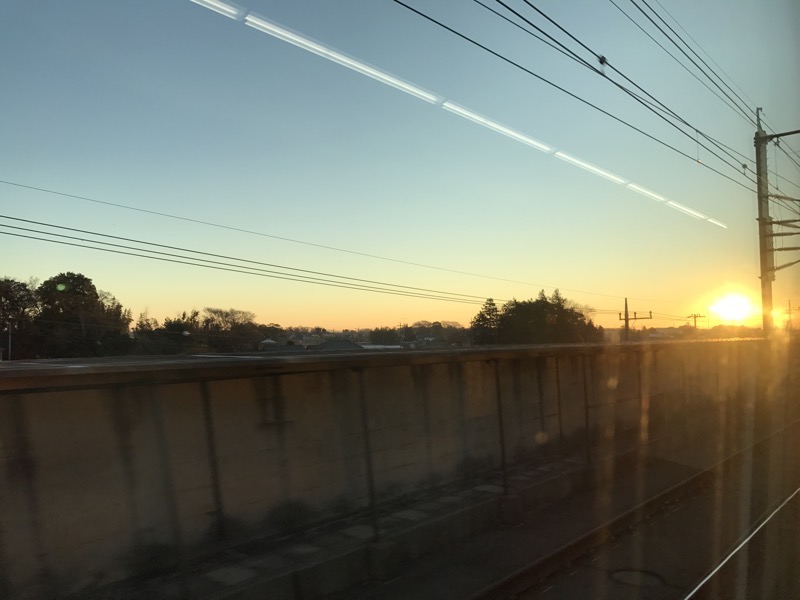
In spite of our inability to get a cup of tea onboard, the train ride was amazing. Comfy, fast, clean and reliable. What’s not to love. Australia really needs some of these bullet trains – we have the distances to cover but unfortunately not so much on having the population to support such services. Once we arrived in Nagano, an immediate change of scenery was apparent – snow everywhere. They had had recent snowfalls the previous few nights and the landscape was beautiful as we made out way to Yamanouchi – the little village close to the Jigokudani park.
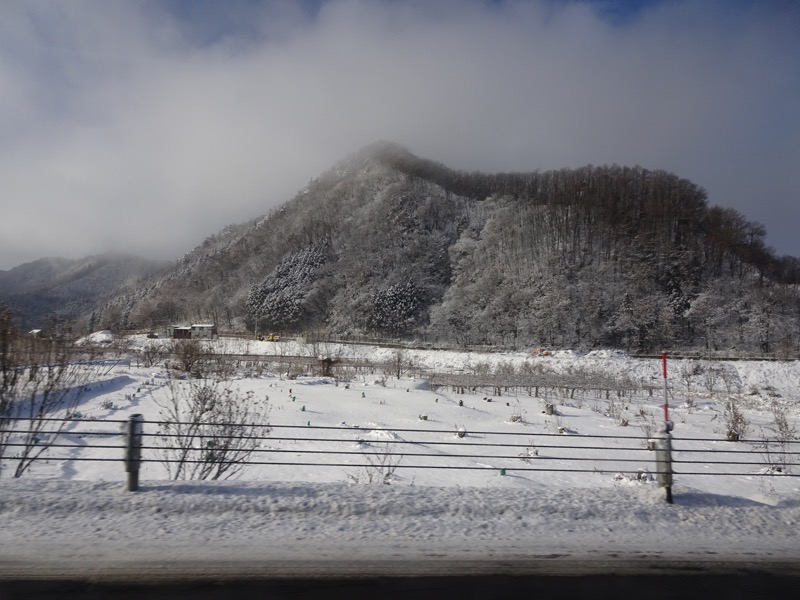 Highspeed landscape photography isn’t really a thing, but you can get a bit of an idea of what the countryside looks like.
Highspeed landscape photography isn’t really a thing, but you can get a bit of an idea of what the countryside looks like.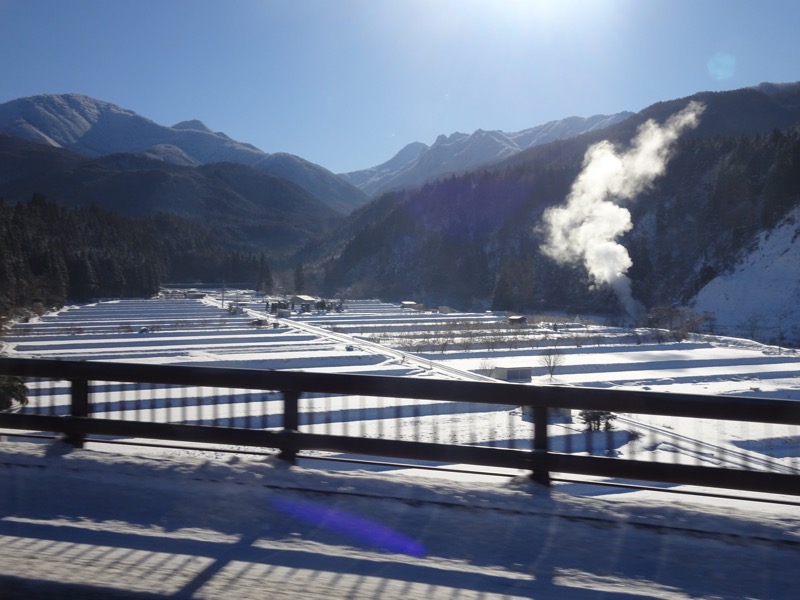
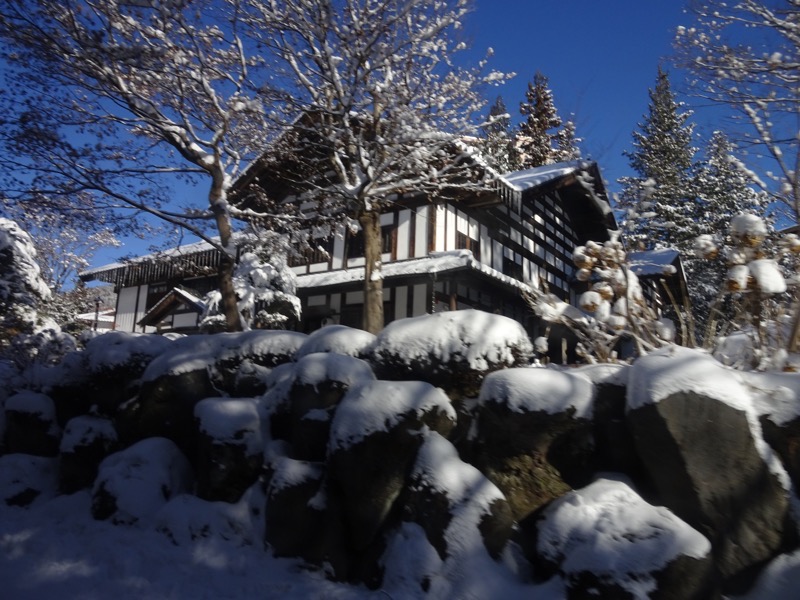
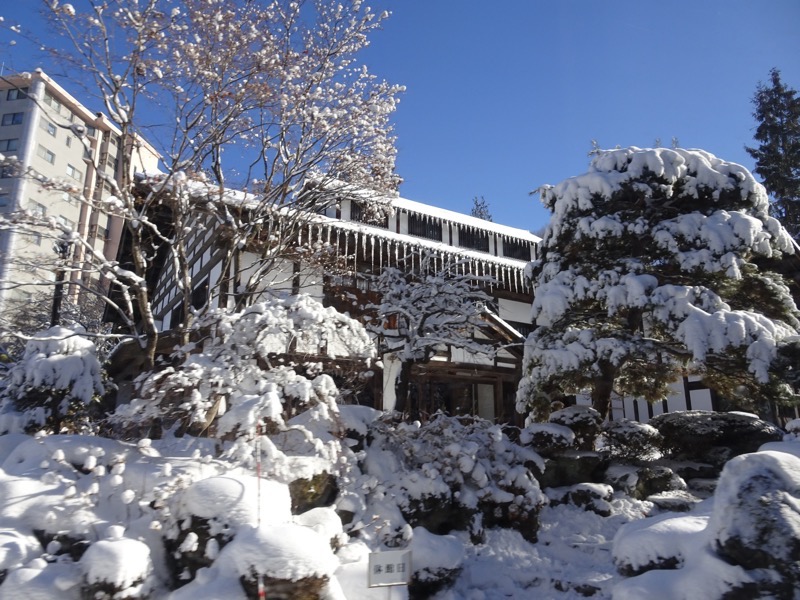
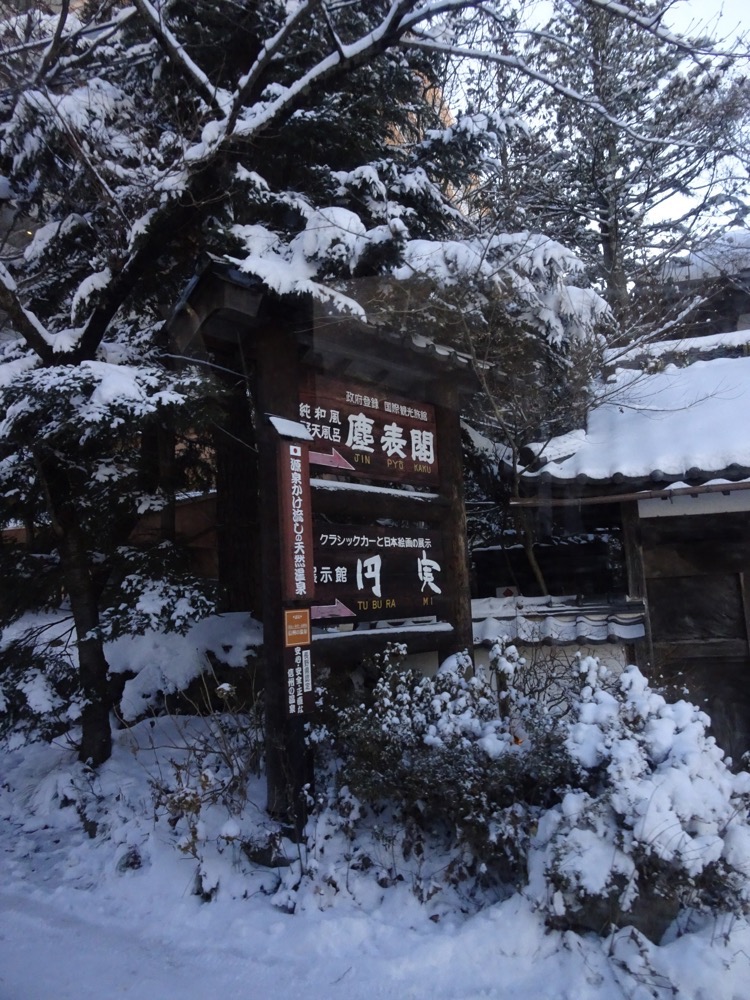 After a 40 minute bus ride, we reached our destination, the entrance to the park. Unsurprisingly, the few restaurants and inns out here seem to use monkeys in their logos.
After a 40 minute bus ride, we reached our destination, the entrance to the park. Unsurprisingly, the few restaurants and inns out here seem to use monkeys in their logos.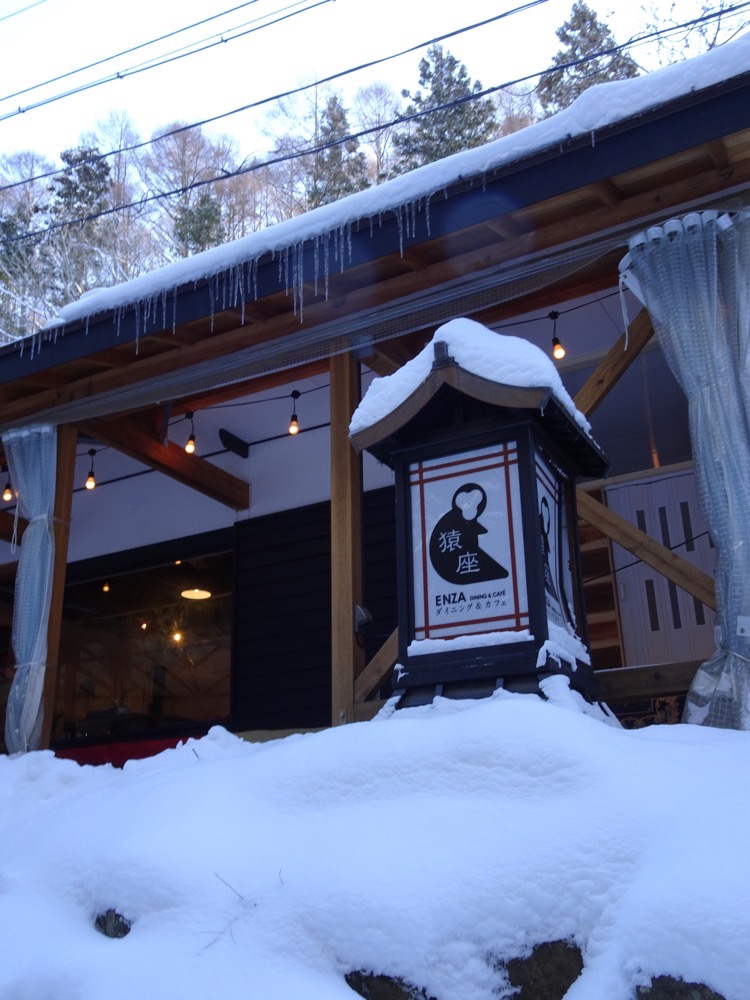 The park entrance leads the way to the 1.6km walk to the thermal pool that the Japanese macaques congregate in during the winter, and it is the only way to access the area. Jigokudani means, ‘Hell’s Valley’ due to the steam and boiling water that is found in the geothermal valley. It is surrounded by steep cliffs that in winter make for a formidable and hostile landscape.
The park entrance leads the way to the 1.6km walk to the thermal pool that the Japanese macaques congregate in during the winter, and it is the only way to access the area. Jigokudani means, ‘Hell’s Valley’ due to the steam and boiling water that is found in the geothermal valley. It is surrounded by steep cliffs that in winter make for a formidable and hostile landscape.
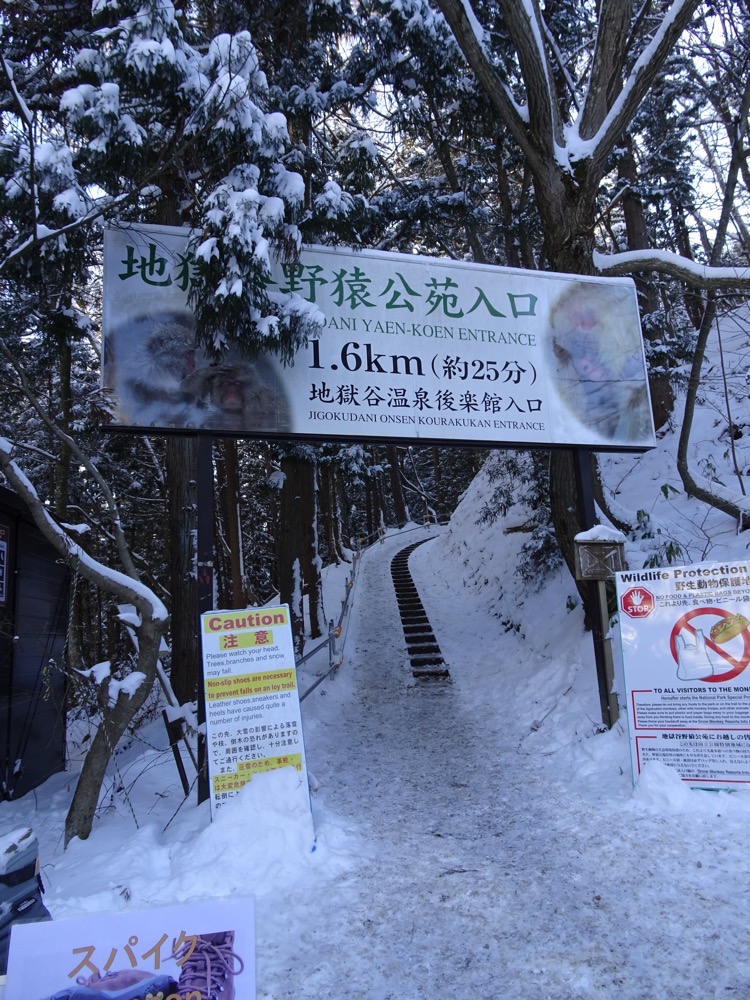
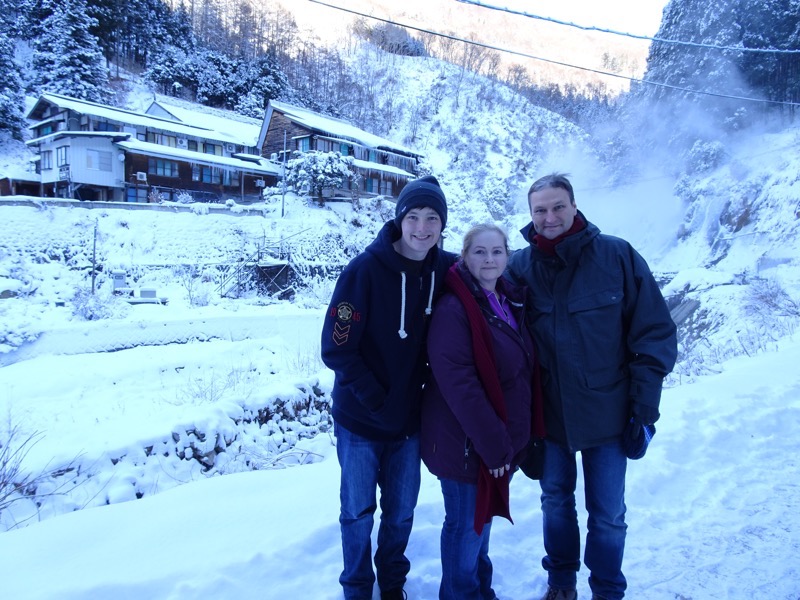 The walk into to the monkey’s thermal pools is fairly flat with only two steep-ish areas, though in these conditions it is very slippery with ice. We all had decent hiking books on but more than one of our party went arse over (including me) on the ice. Ice or no, it sure is beautiful to see the valley covered in a layer of fresh snow.
The walk into to the monkey’s thermal pools is fairly flat with only two steep-ish areas, though in these conditions it is very slippery with ice. We all had decent hiking books on but more than one of our party went arse over (including me) on the ice. Ice or no, it sure is beautiful to see the valley covered in a layer of fresh snow.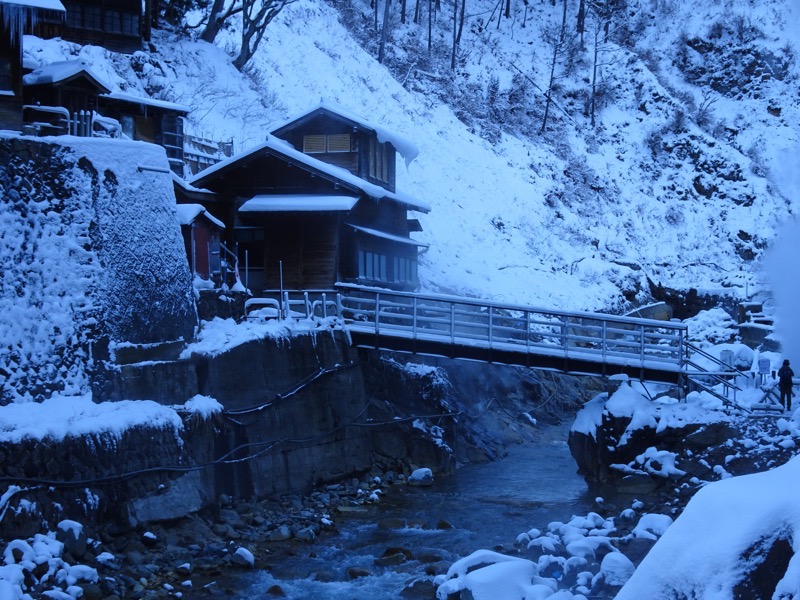
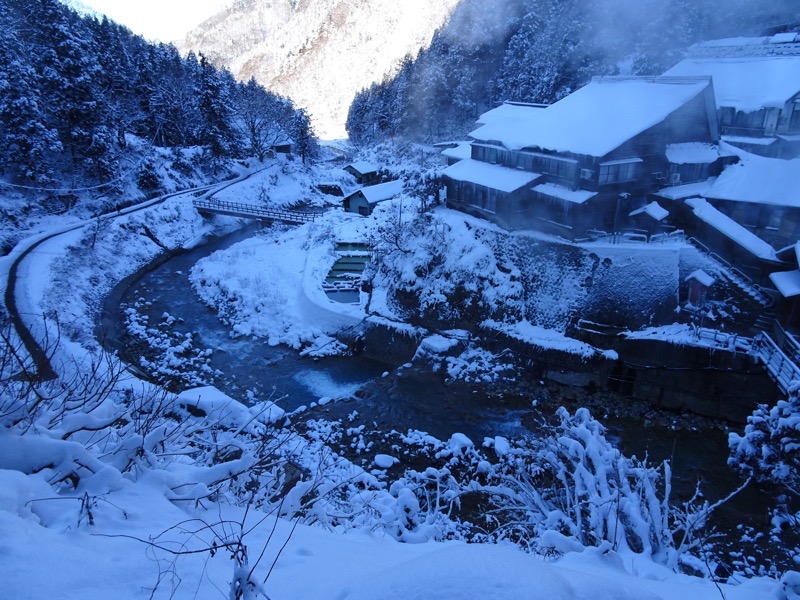
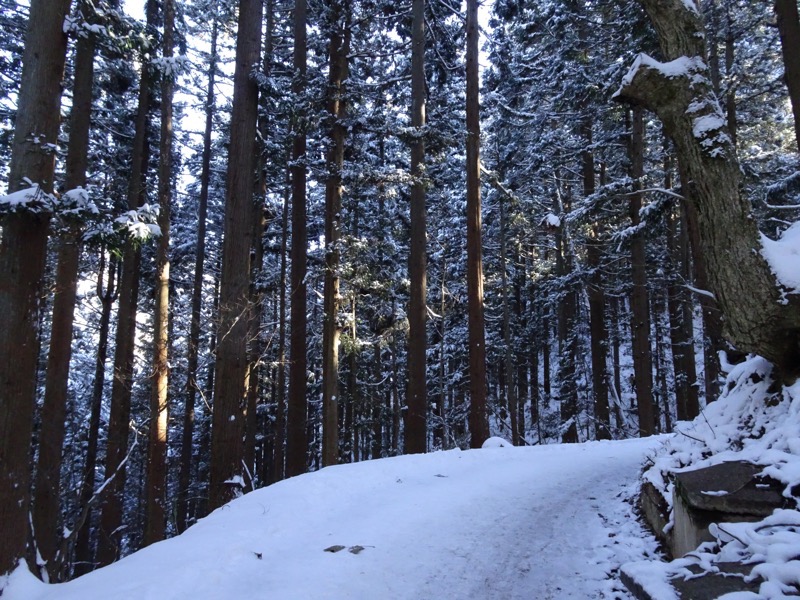
Back in the 60s, the monkeys were problematic. They were encountering a reduced habitat due to farming, the installation of ski lifts in the Shiga Kogen area in 1952 and the permanent installation of onsen bathhouses in the area. As a result of this habitat loss, they were migrating into Yamanouchi during the winter months to forage and being come quite a pest as they were destroying crops, invading the onsens and being aggressive with humans over food resources. Farmers had been culling the monkeys until a man named Sogo Hara, (who was employed at the Nagano Electric Railway – Nagano Dentetsu) hiked the area in 1957 and apparently fell in love with the monkeys and decided they needed their own onsens in the valley, and he built them a thermal pool and started feeding them every day to encourage them to stay out of the village; creating the Jigokudani Monkey Park. Now, no tourist brochure for Japan is complete without the obligatory images of the Japanese macaque monkeys sitting, looking somewhat forlorn in their onsen, and they have become a world-famous tourist attraction.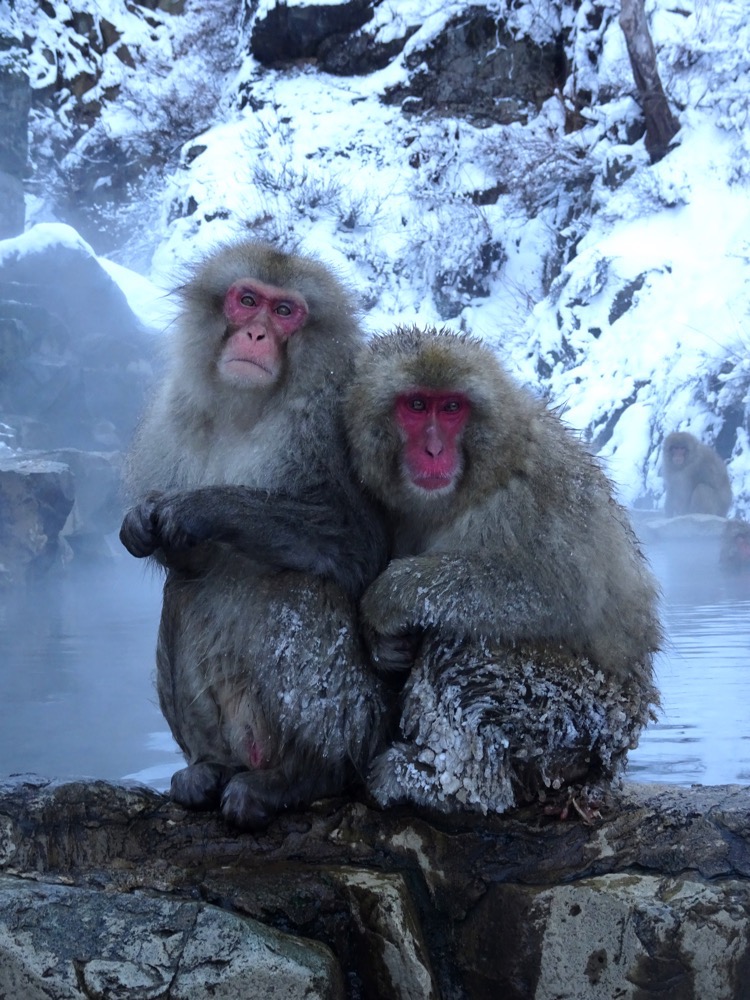
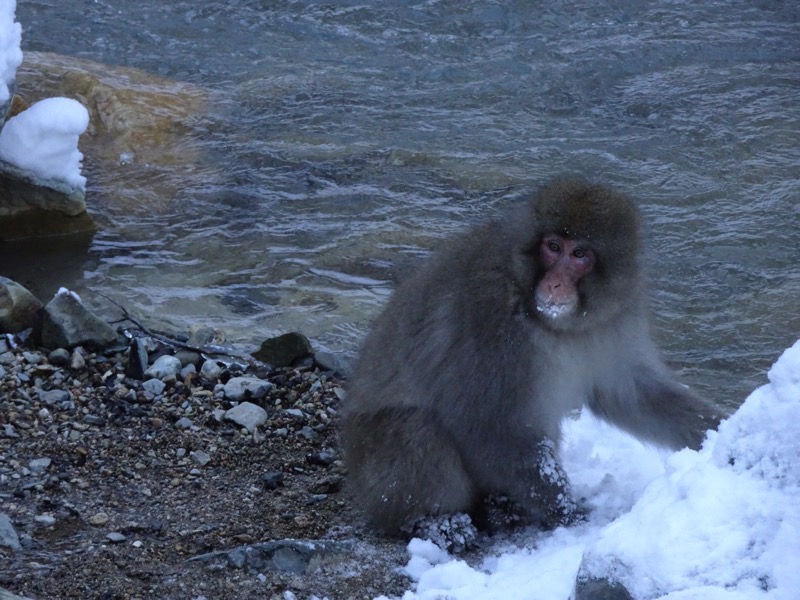
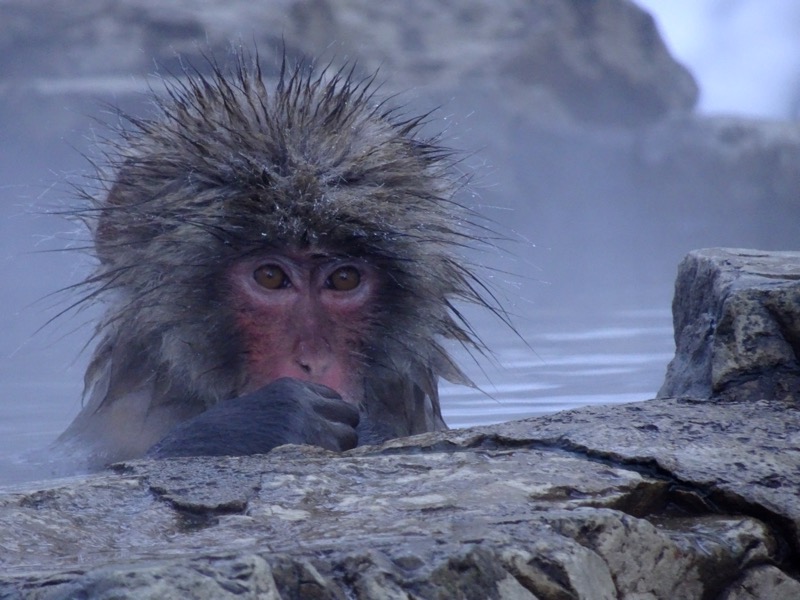
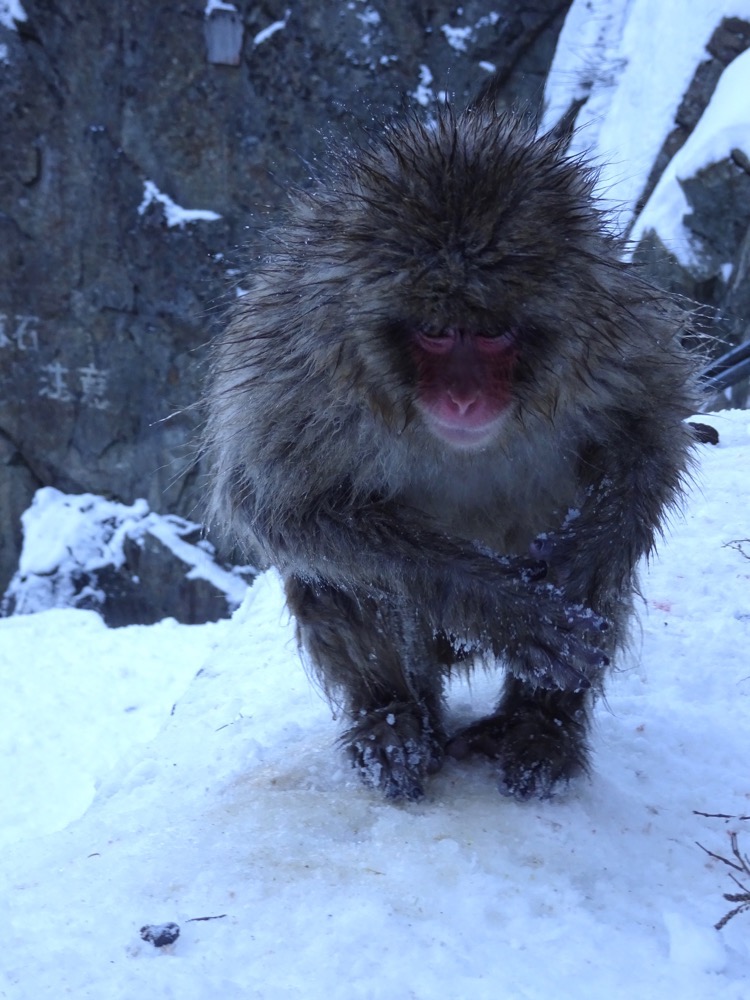
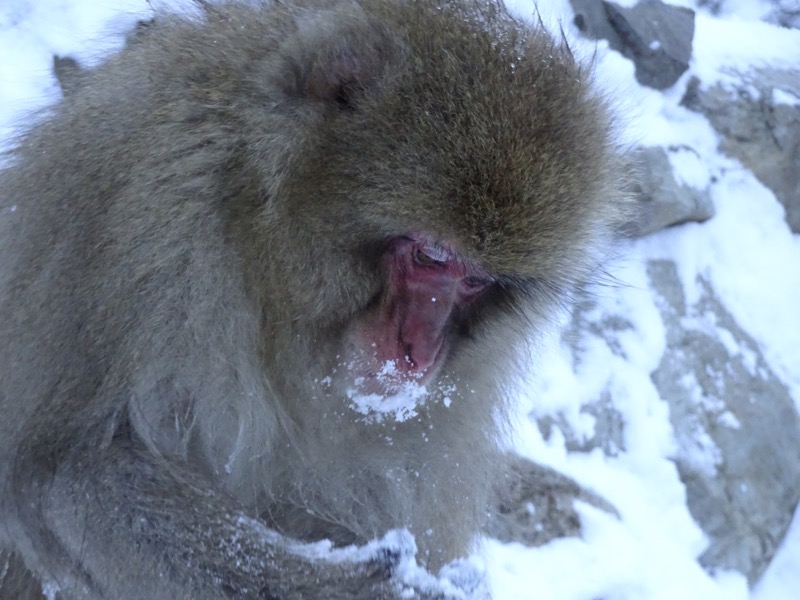
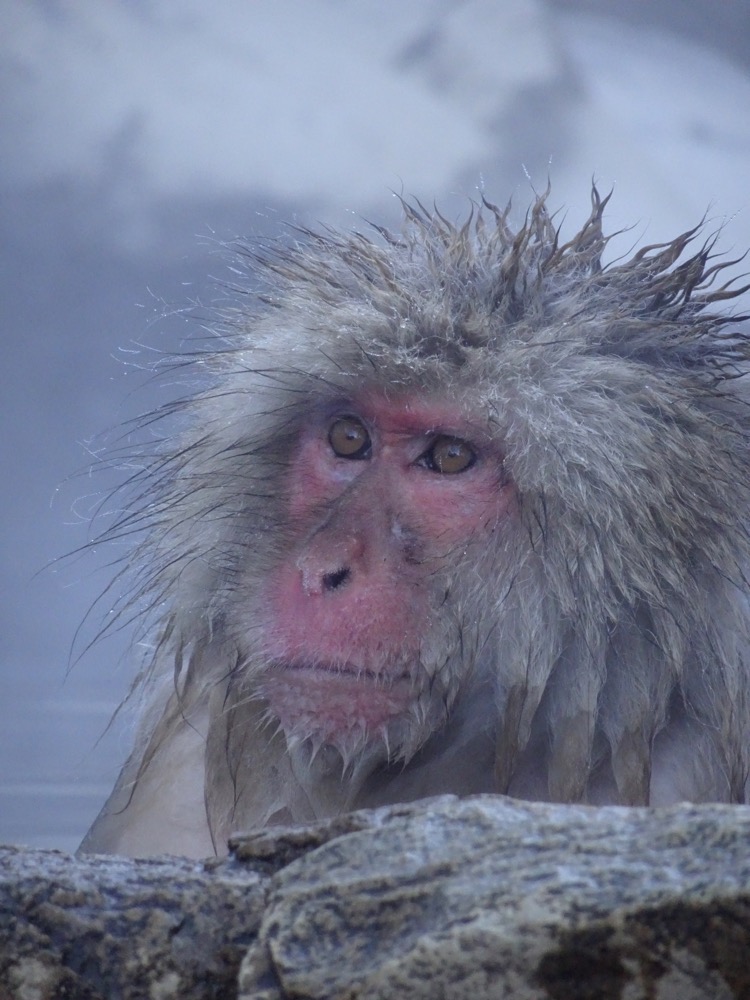
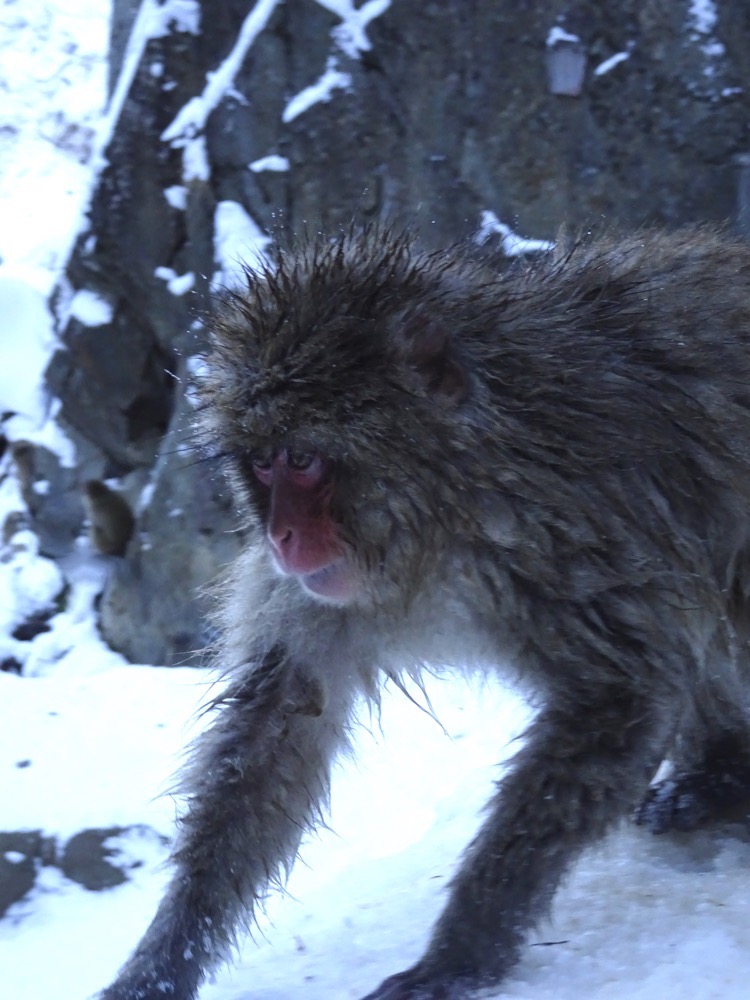
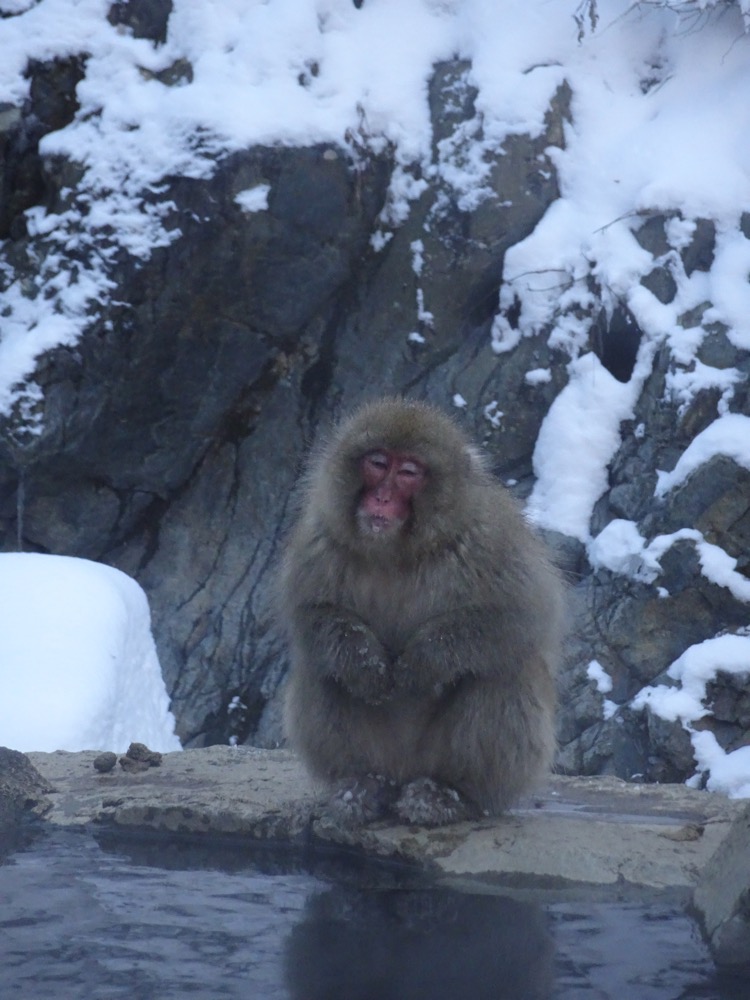
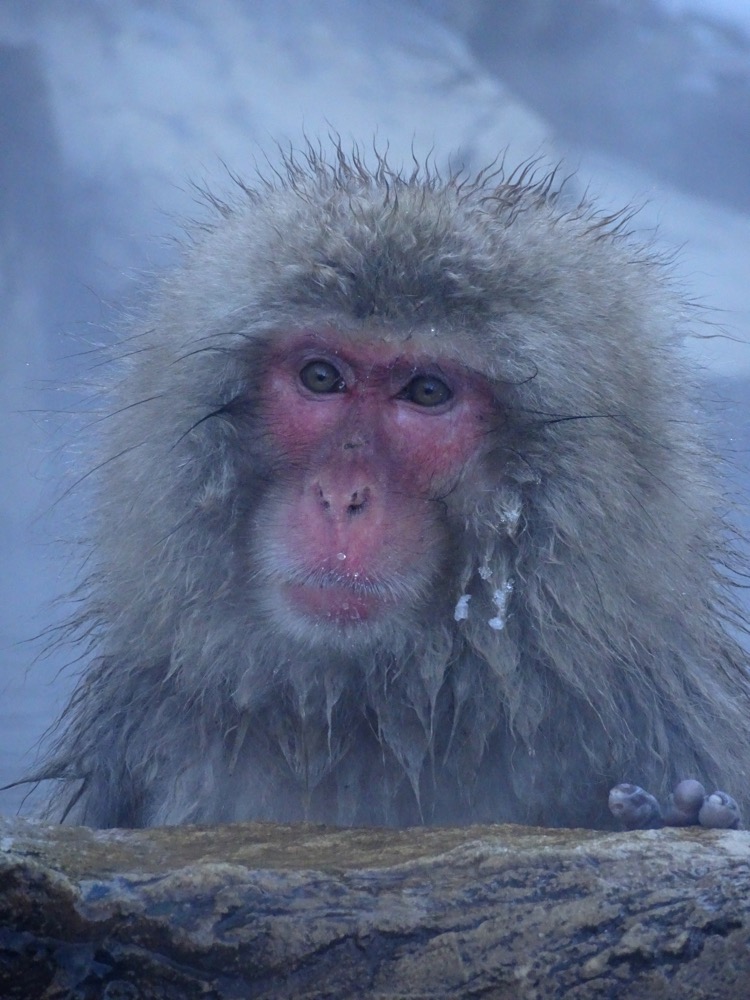
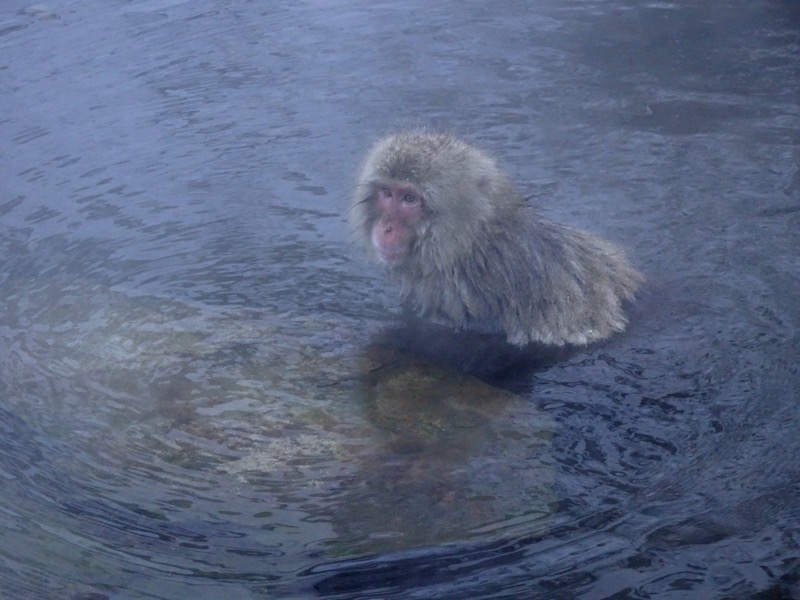
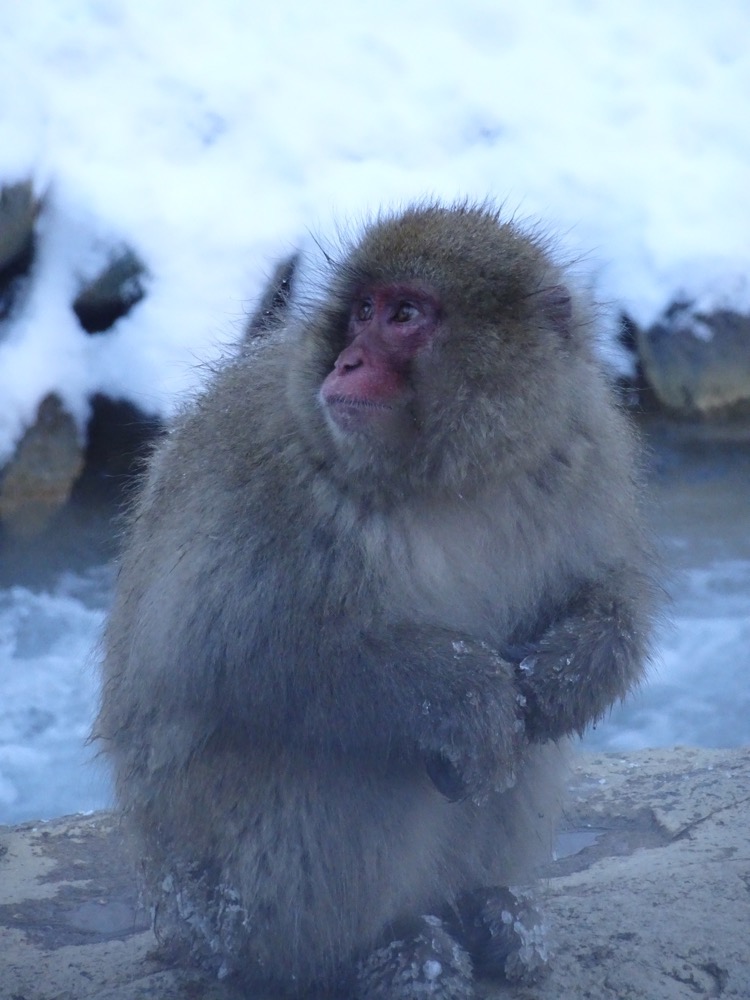
I took so many photos of the monkeys, they’re very interesting with their almost human mannerisms and expressions. It was approximately -3degrees celsius and I can easily see why the monkeys choose to come to the valley to sit in the thermal pools, but occasionally you see one jump out and go run off into the snow, which must be excruciatingly cold.
Icicles! Which are pretty ordinary if you come from Michigan or somewhere, but if you’re from Brisbane, Australia.. how cool are icicles?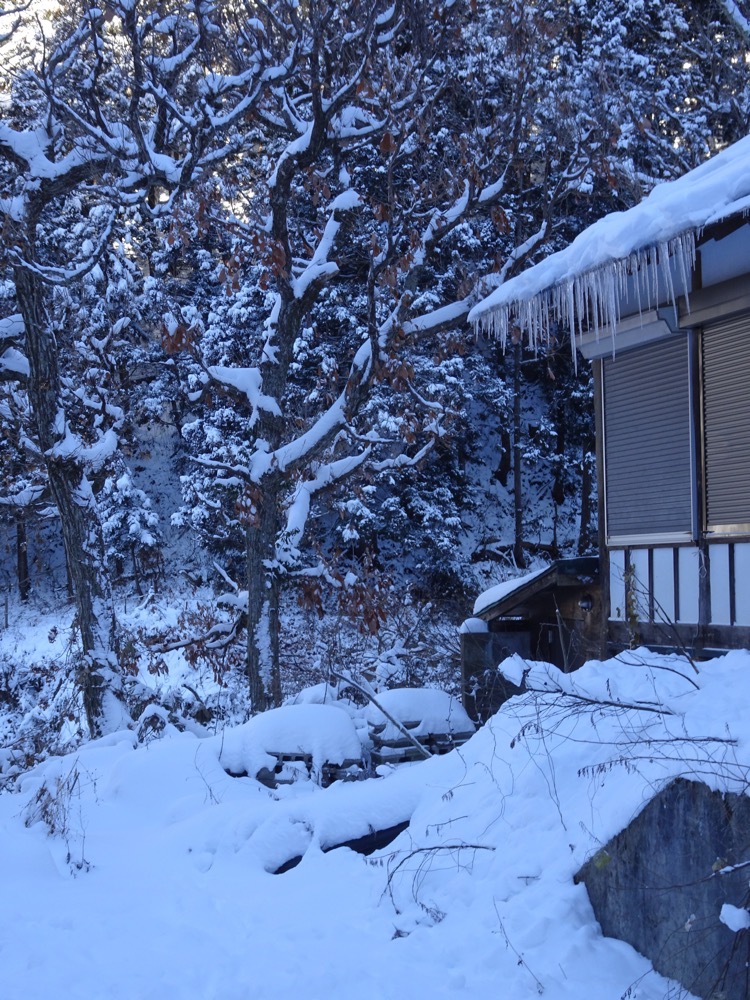
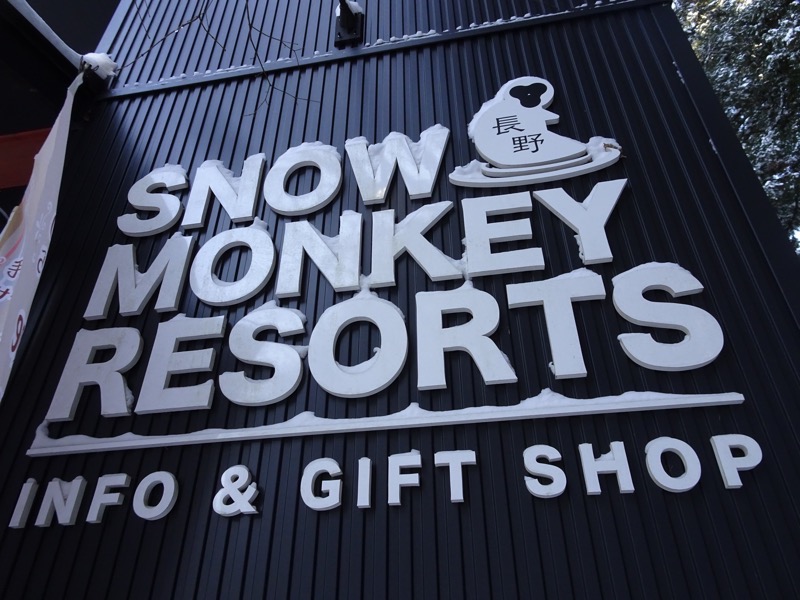 The drive back from the park afforded some beautiful views of the mountains in the Nagano area. The Winter Olympics were held here nearly 20 years ago, but the locals like to keep showing that one off with souvenirs still available and signs to the event sites.
The drive back from the park afforded some beautiful views of the mountains in the Nagano area. The Winter Olympics were held here nearly 20 years ago, but the locals like to keep showing that one off with souvenirs still available and signs to the event sites.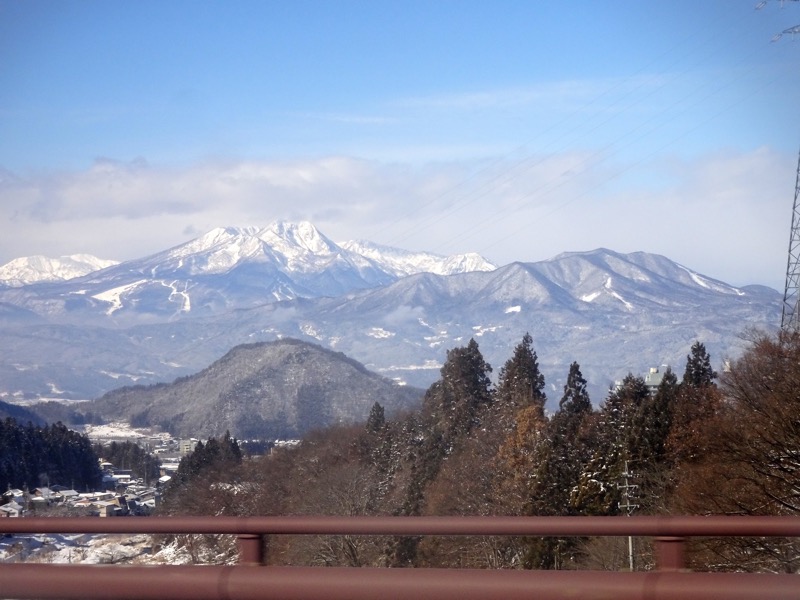 After visting the snow monkeys we made out way to the Zenkō-ji temple, one of the most famouse Buddhist temples in all of Japan. The original temple was built in the 7thC AD and the city of Nagano which was established in 1897 was effectively built up around the temple area. HIstorically Zenkō-ji is famous for it’s use as a staging point in the battles between Uesugi Kenshin and Takeda Shngen in the 16thC. It is also one of the few temples which serve as a pilgrimage site in Japan.
After visting the snow monkeys we made out way to the Zenkō-ji temple, one of the most famouse Buddhist temples in all of Japan. The original temple was built in the 7thC AD and the city of Nagano which was established in 1897 was effectively built up around the temple area. HIstorically Zenkō-ji is famous for it’s use as a staging point in the battles between Uesugi Kenshin and Takeda Shngen in the 16thC. It is also one of the few temples which serve as a pilgrimage site in Japan.
The main entrance gate.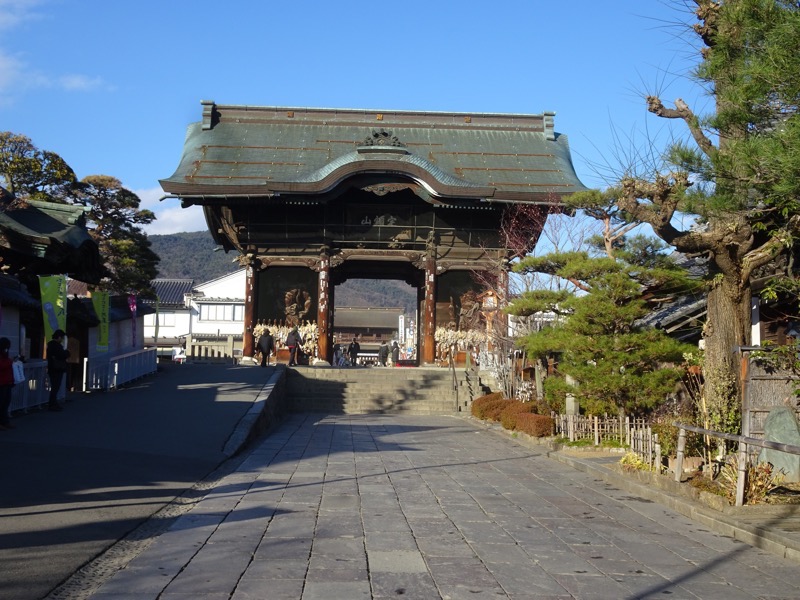
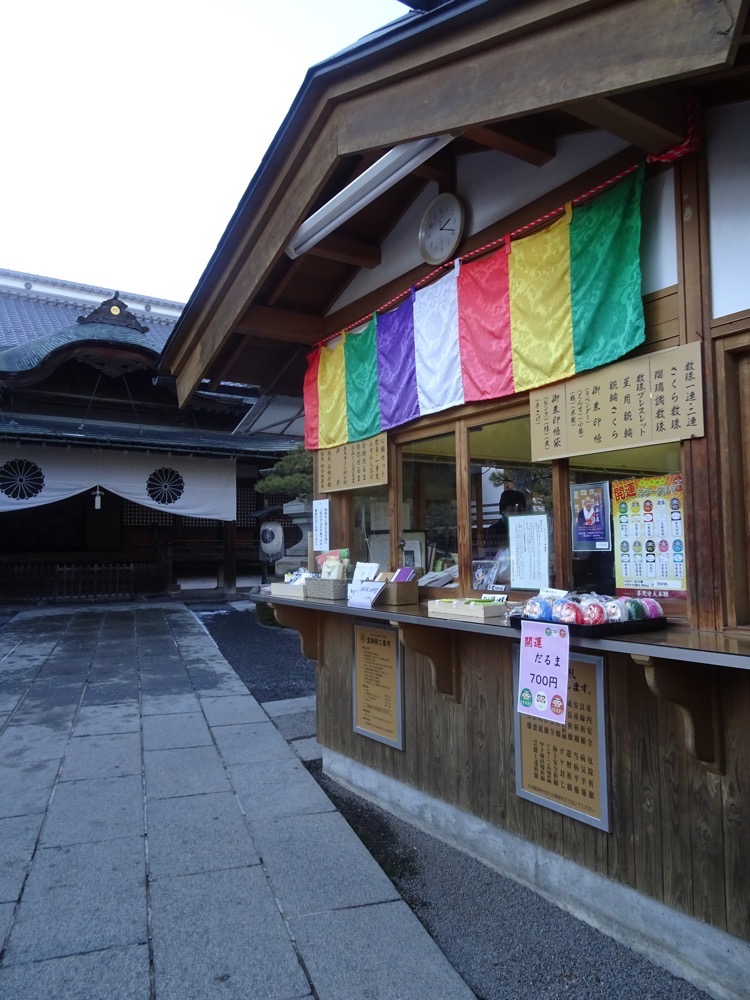
Zenkō-ji temple was founded before Japanese Buddhism split into different sects, so it is one of the only temples in Japan that belongs to more than one sect of Buddhism. At the moment the Tendai and Jōdoshū schools co-manage the temple, and it takes twenty-five priests and fourteen priests/priestess respectively to run the temple. According to legend, the temple was built to enshrine images of the Amida Buddha, which had caused a dispute between two warring clans and was allegedly dumped into a canal. It was rescued by someone named, Honda Yoshimitsu but it is now called the hibutsu, or hidden Buddha and is not available to be seen by the public. A replica was made of the hidden Buddha, but guess what? This one too is not available for viewing by the public! There is however, a replica of the replica and it IS available for the public to see.
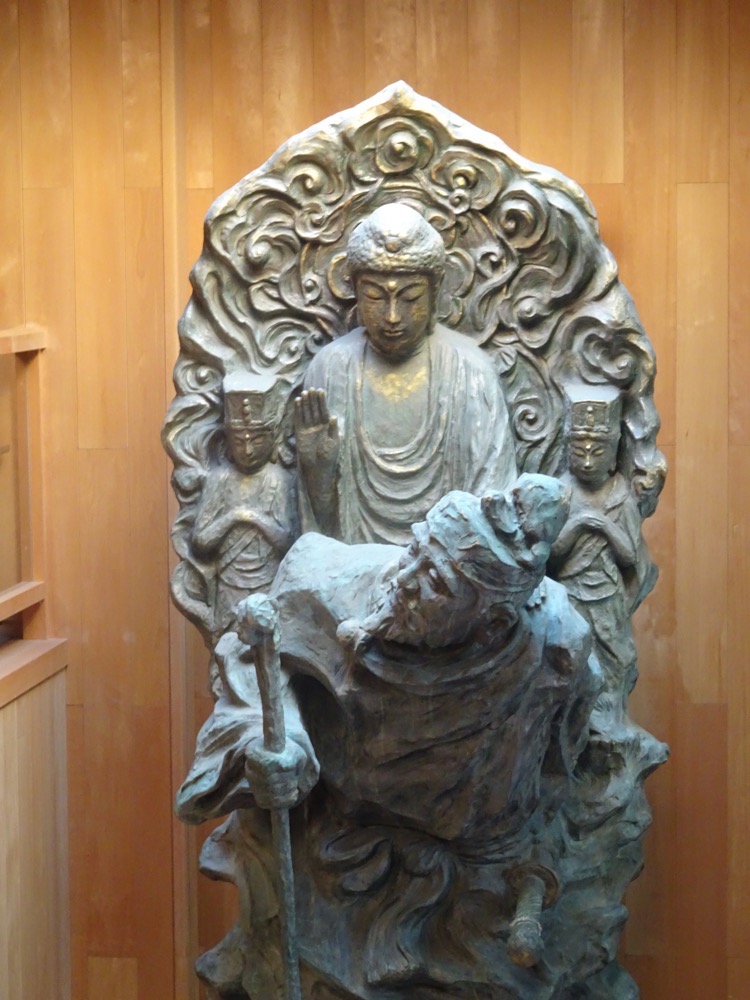 This hibutsu hidden Buddha, is rumored to be the very first Buddha statue ever brought to Japan and it is by ‘commandment’ of the temple that the absolute secrecy of the statue is maintained. Even the chief priest of the temple is unable to view it. The first replica however, (not the one above) is shown publicly once every six years in the spring time in a truly bizarre special ceremony called Gokaichō.
This hibutsu hidden Buddha, is rumored to be the very first Buddha statue ever brought to Japan and it is by ‘commandment’ of the temple that the absolute secrecy of the statue is maintained. Even the chief priest of the temple is unable to view it. The first replica however, (not the one above) is shown publicly once every six years in the spring time in a truly bizarre special ceremony called Gokaichō. 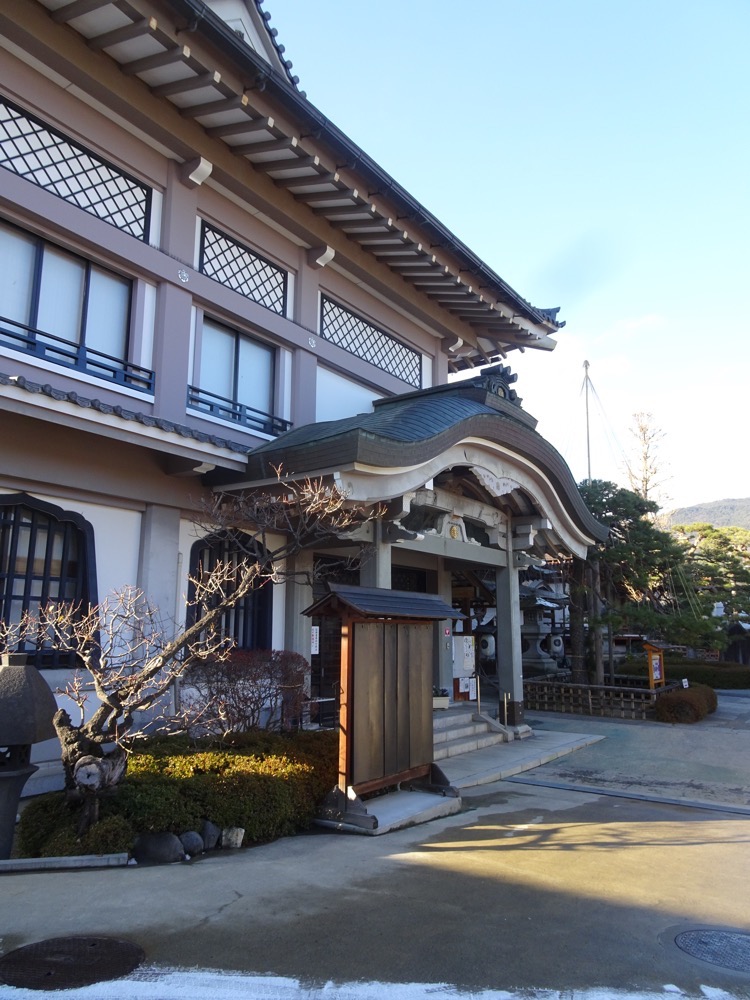
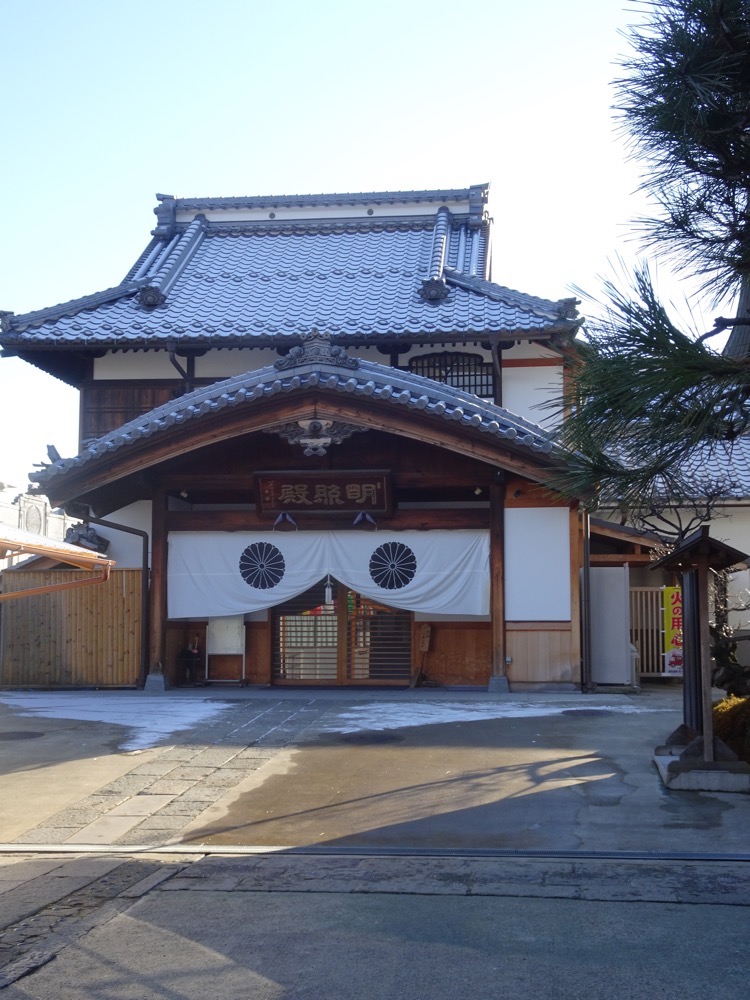 Nearby is the Scholar’s Shrine – students will come here to make offerings to pass their exams. They will give their coins, write on a stone their desire to pass their tests, and then strike the gong using the rope. Passing exams in Japan can mean the difference between a happy life of lifelong prosperity working for a good company, and a life of destitution floating from job to job. Obviously, the pursuit of a ‘life-job’ is become less of a goal in the fluid modern job market.
Nearby is the Scholar’s Shrine – students will come here to make offerings to pass their exams. They will give their coins, write on a stone their desire to pass their tests, and then strike the gong using the rope. Passing exams in Japan can mean the difference between a happy life of lifelong prosperity working for a good company, and a life of destitution floating from job to job. Obviously, the pursuit of a ‘life-job’ is become less of a goal in the fluid modern job market.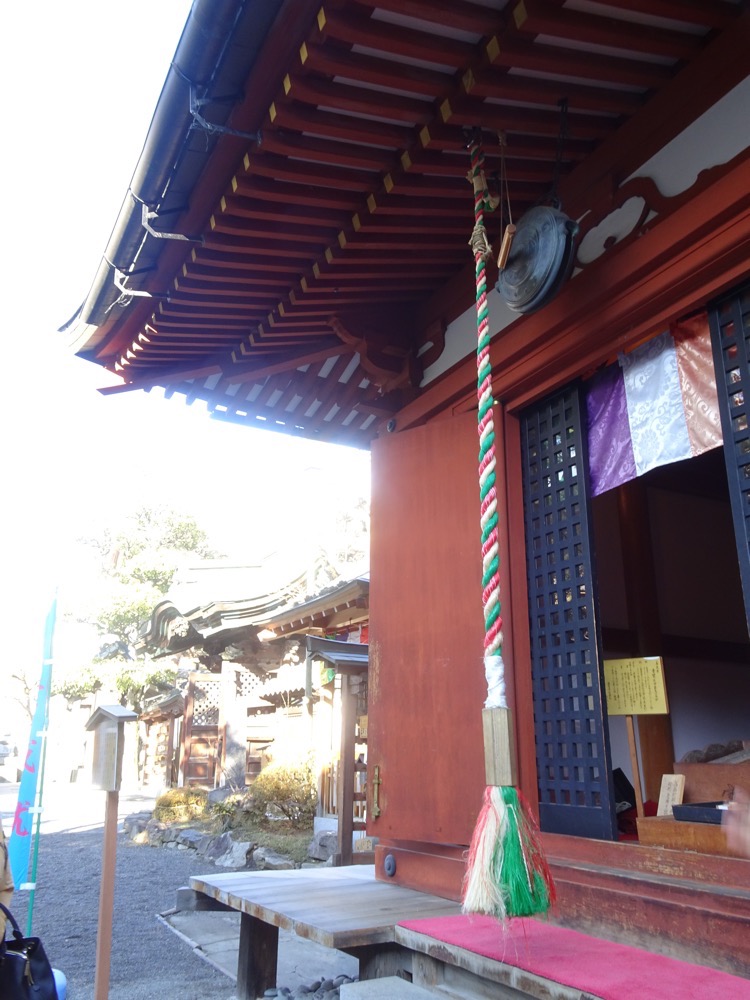
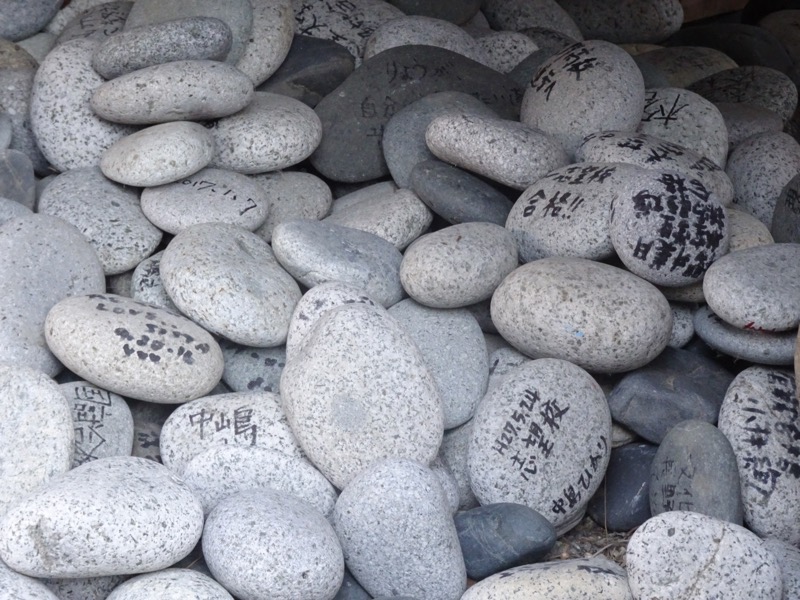
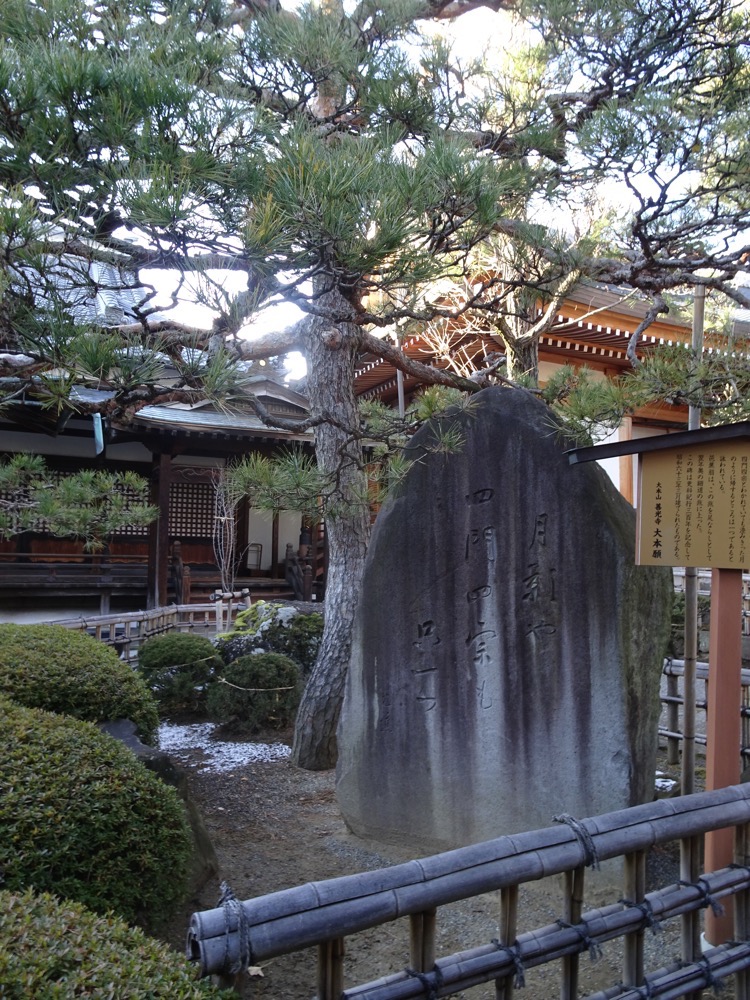
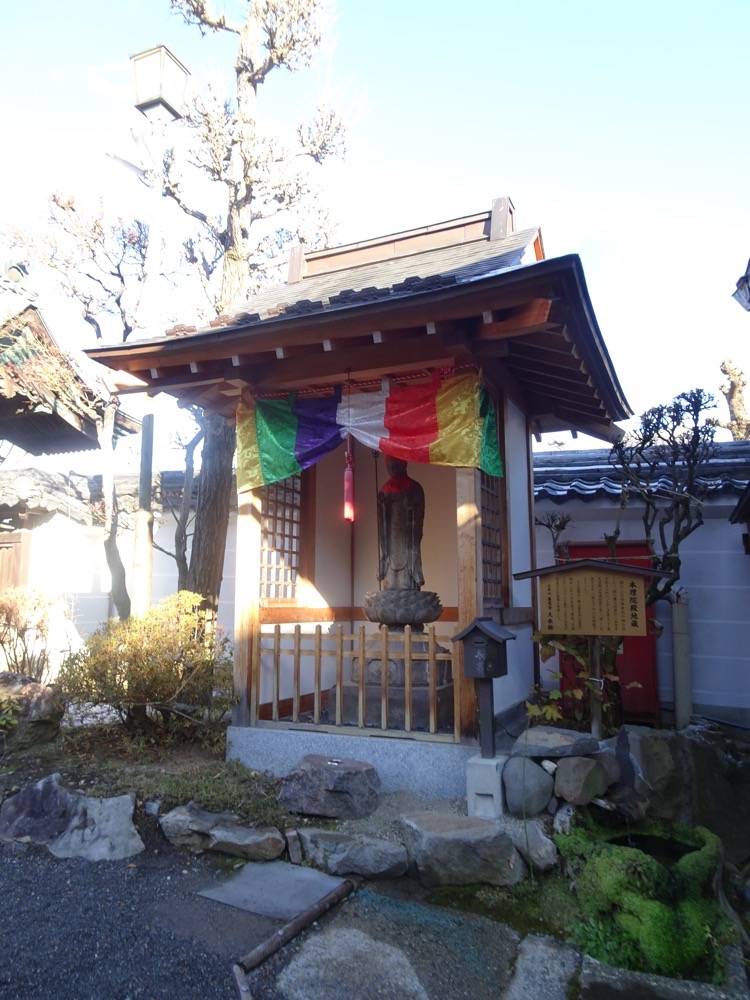
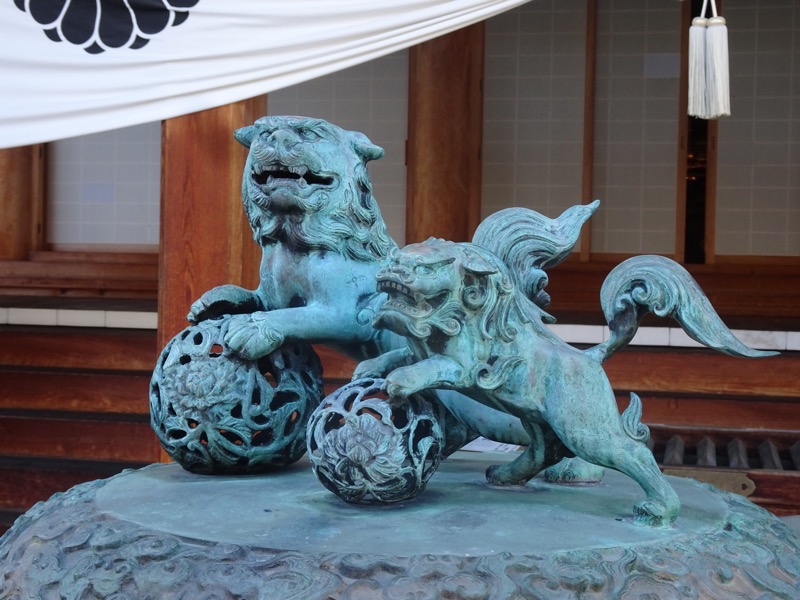 A very sad monument to children and babies that have died. People who visit this shrine all have a very heart-wrenching story to share. There are two shrines dedicated to this purpose in the temple complex.
A very sad monument to children and babies that have died. People who visit this shrine all have a very heart-wrenching story to share. There are two shrines dedicated to this purpose in the temple complex.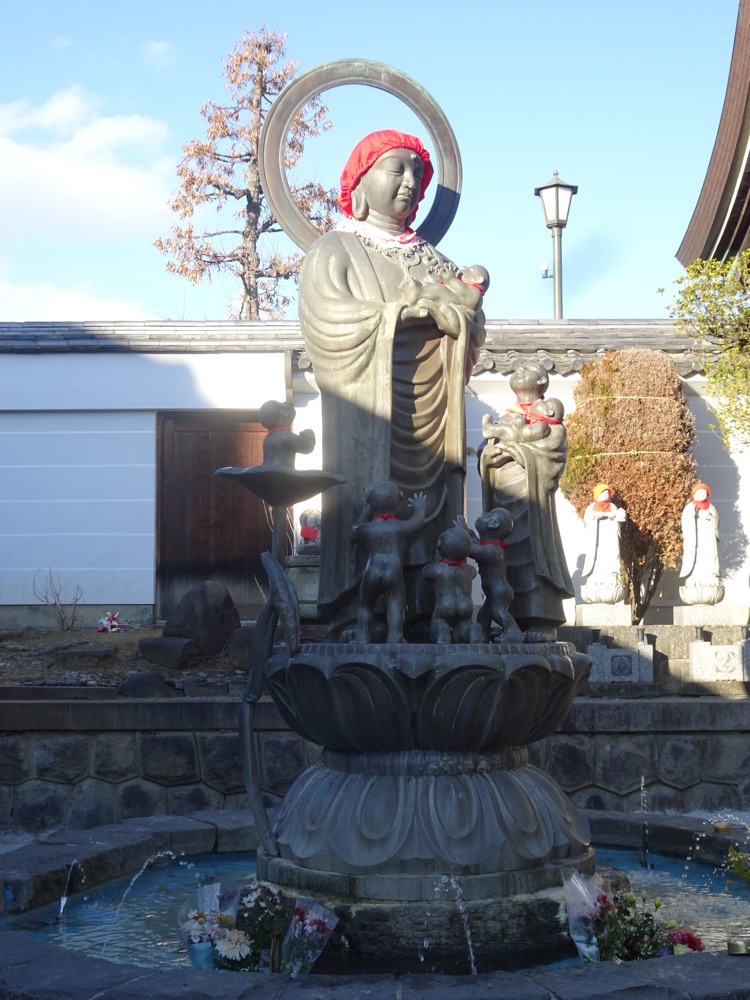
The Niōmon gate contains two impressive Niō guardians, which are supposed to protect the compound from enemies of Buddhism. Both statues were reproduced in 1918 after a fire. Fires seem to have plagued the town since it’s inception with the main temple having burned down no less than 12 times. Until it was finally moved further away from the town centre to protect the surrounding buildings.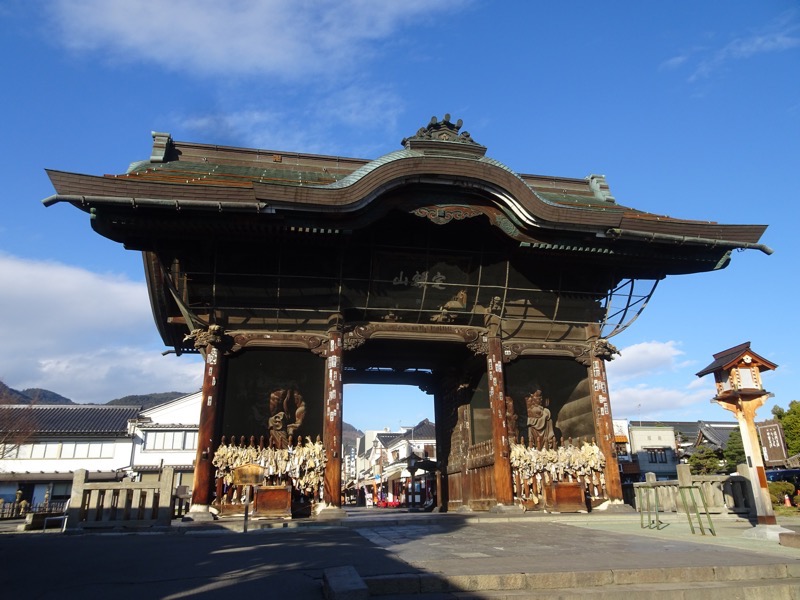 Pilgrims sandals hung on the outside of the Niōmon gate hung when pilgrims set off on their journeys to give them good strong legs for their endeavours. Also hung here can be found pairs of ballet slippers for aspiring ballerinas who also want to have good strong legs for their careers.
Pilgrims sandals hung on the outside of the Niōmon gate hung when pilgrims set off on their journeys to give them good strong legs for their endeavours. Also hung here can be found pairs of ballet slippers for aspiring ballerinas who also want to have good strong legs for their careers.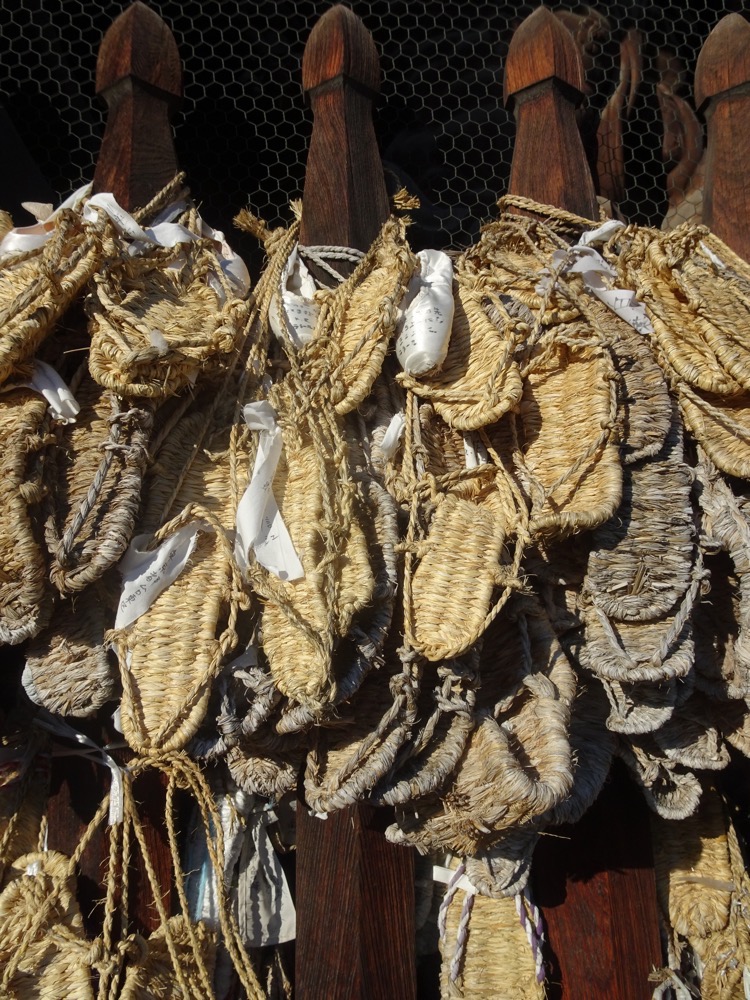 The interior of the Sanmon gate is covered in plastered on papers or stickers bearing people’s names. While it is illegal to place these stickers, it is said that the higher you place your name, the higher you are towards enlightenment. Some very determined individuals have their names as much as 6m off the ground. Oddly (given you are literally leaving evidence of your crime) no one is ever prosecuted for leaving a name sticker due to Japanese naming protocols leaving so many people with identical or similar names.
The interior of the Sanmon gate is covered in plastered on papers or stickers bearing people’s names. While it is illegal to place these stickers, it is said that the higher you place your name, the higher you are towards enlightenment. Some very determined individuals have their names as much as 6m off the ground. Oddly (given you are literally leaving evidence of your crime) no one is ever prosecuted for leaving a name sticker due to Japanese naming protocols leaving so many people with identical or similar names.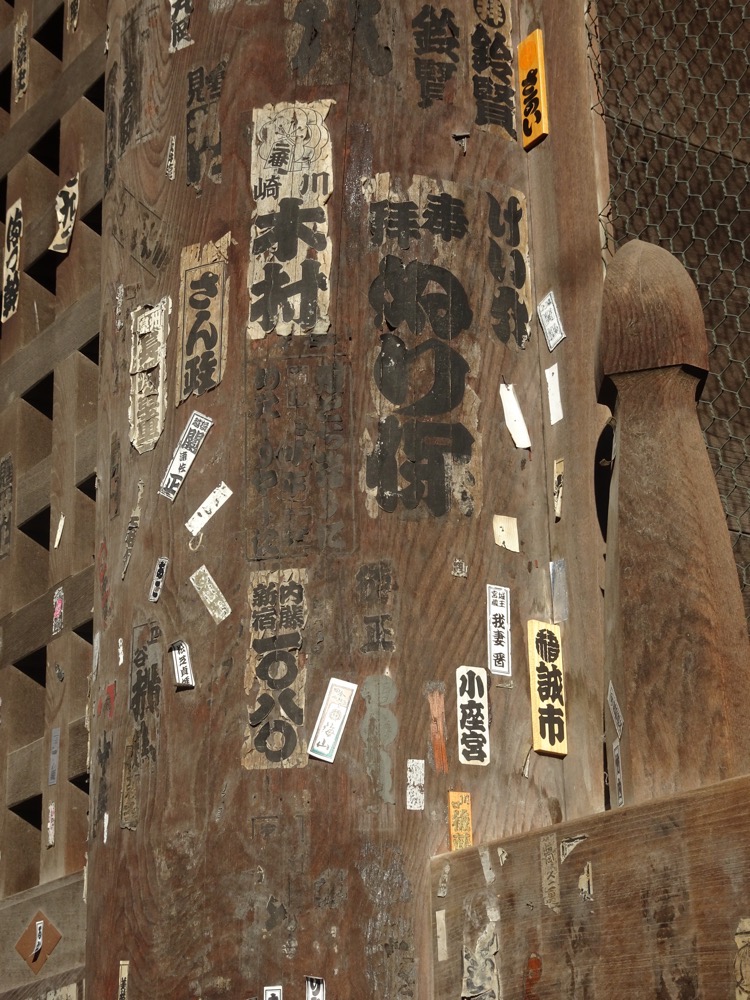 Another shrine, this time dedicated to long life and good health. This shrine is the ‘reason’ that the people of Nagano are known to live the longest lives, of all the Japanese people. Nothing to do with healthy living and good diets, it is this little shrine which brings them longevity.
Another shrine, this time dedicated to long life and good health. This shrine is the ‘reason’ that the people of Nagano are known to live the longest lives, of all the Japanese people. Nothing to do with healthy living and good diets, it is this little shrine which brings them longevity.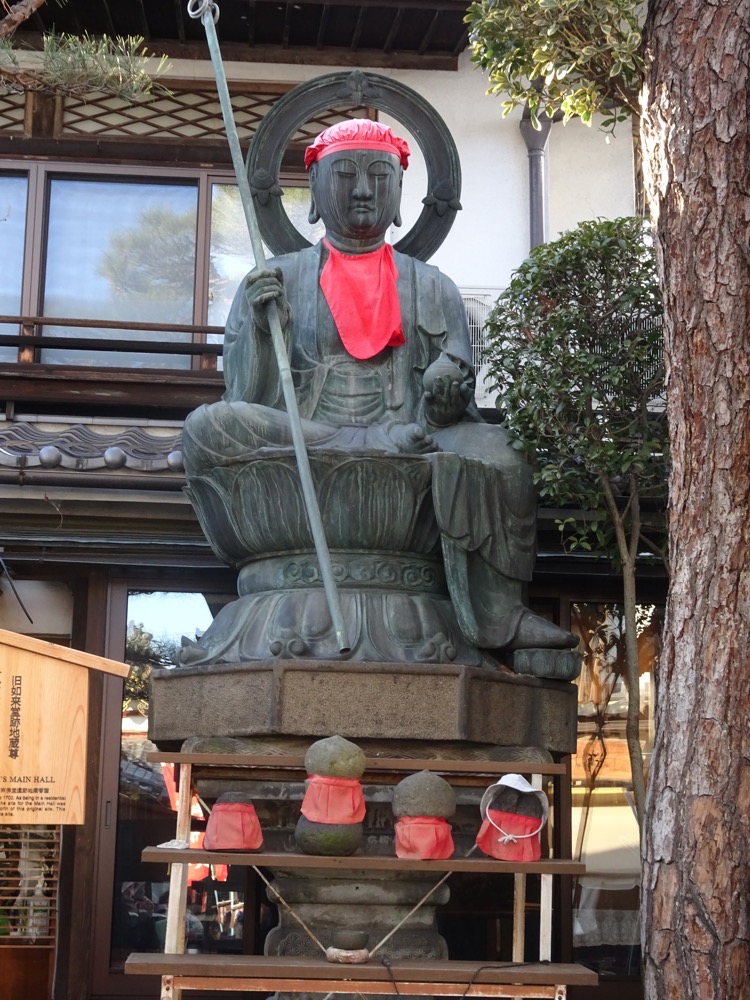 This bronze oxen has a special house to himself and he has come to represent ‘Unexpected Good Fortune’. The story of the oxen includes a washerwoman who did not believe in spending her time going to the shrine to pay her respects to Buddha. While the rest of the townsfolks would go to the shrine, she instead would go to the river to wash her clothes. Buddha was annoyed by this, and one day he turned himself into an ox and ran through the washerwoman’s clothes collecting them on his horns. Away he ran, with the washerwoman following him, to the shrine, whereupon he turned into his proper self and showed himself to the washerwoman wearing the clothing she had been washing.
This bronze oxen has a special house to himself and he has come to represent ‘Unexpected Good Fortune’. The story of the oxen includes a washerwoman who did not believe in spending her time going to the shrine to pay her respects to Buddha. While the rest of the townsfolks would go to the shrine, she instead would go to the river to wash her clothes. Buddha was annoyed by this, and one day he turned himself into an ox and ran through the washerwoman’s clothes collecting them on his horns. Away he ran, with the washerwoman following him, to the shrine, whereupon he turned into his proper self and showed himself to the washerwoman wearing the clothing she had been washing.
The woman saw the errors of her ways and was then set onto the path of Enlightenment and became a Buddhist nun directly after – the unexpected good luck of the story. Now people come here to touch and caress the ox to bring an event of unexpected good luck into their own lives. 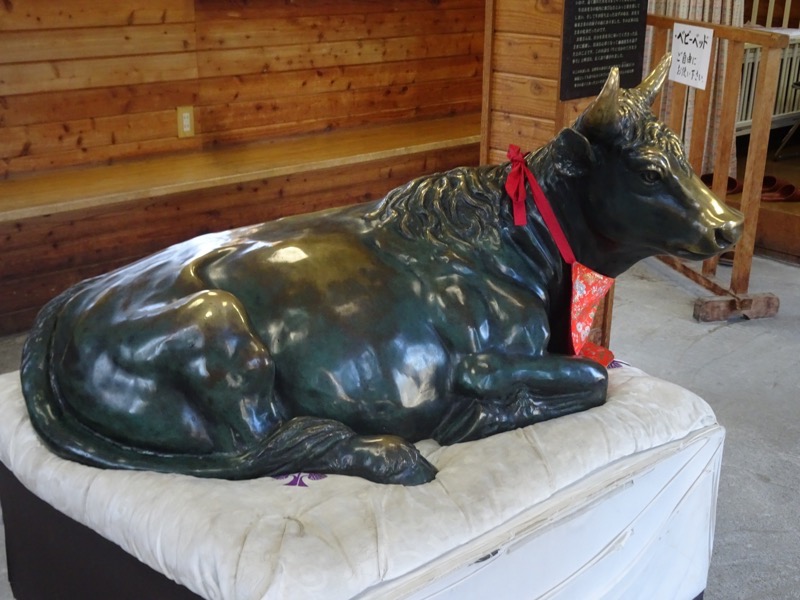
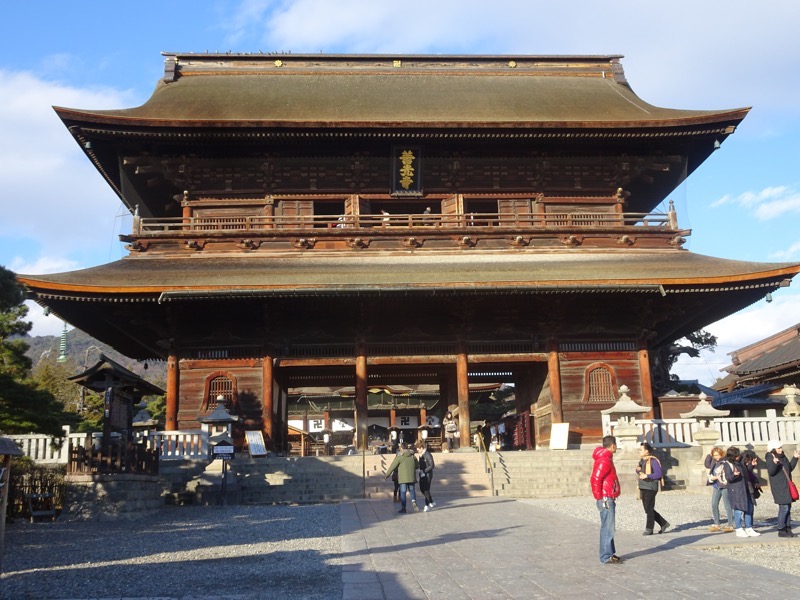 Outside the temple are statues of six Bodhisattvas (followers of Buddha), who gave up their own pursuit of Buddhist enlightenment, in order to help and provide salvation to others. The Bodhisattvas are said to represent and be able to commune with the six realms of hell, starvation, beasts, carnage, human beings and divine beings. The Bodhisattva on the right with his foot dangling in the mortal world is the one representing hell.
Outside the temple are statues of six Bodhisattvas (followers of Buddha), who gave up their own pursuit of Buddhist enlightenment, in order to help and provide salvation to others. The Bodhisattvas are said to represent and be able to commune with the six realms of hell, starvation, beasts, carnage, human beings and divine beings. The Bodhisattva on the right with his foot dangling in the mortal world is the one representing hell.

The washerwoman chasing the ox is a repeated symbol of the temple with the motif being found on headscarves, offerings and prayer plaques.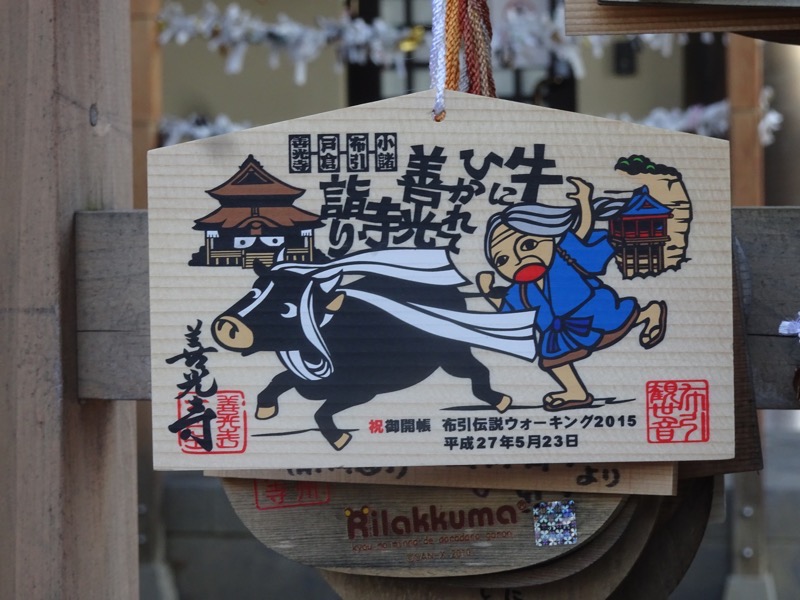 This is the main temple of the Zenkoji temple complex. Inside is housed five sacred wooden statues, which, you guessed it – are not available for public viewing. Also inside the temple is a statue of Binzuru, a physician who was said to be Buddha’s follower. Visitors to the temple touch the statue in order to cure their ailments – so if you have bad knees you touch his knees, if you have a bad back… you get the idea. The statue of Binzuru is made of wood and is 300 years old, I’m surprised that people are still allowed to touch a religious artefact of this age – but of course I rubbed his back anyway!
This is the main temple of the Zenkoji temple complex. Inside is housed five sacred wooden statues, which, you guessed it – are not available for public viewing. Also inside the temple is a statue of Binzuru, a physician who was said to be Buddha’s follower. Visitors to the temple touch the statue in order to cure their ailments – so if you have bad knees you touch his knees, if you have a bad back… you get the idea. The statue of Binzuru is made of wood and is 300 years old, I’m surprised that people are still allowed to touch a religious artefact of this age – but of course I rubbed his back anyway! 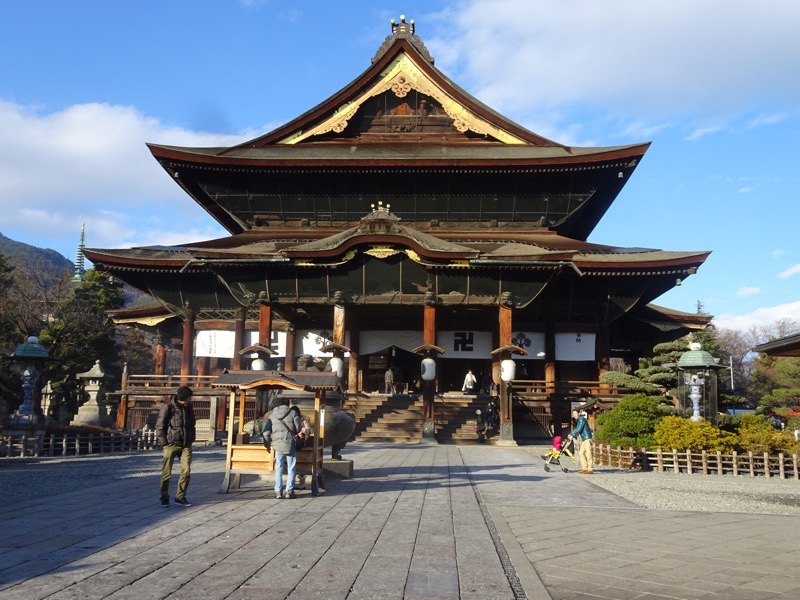
Also inside the temple is The Key to Paradise – it is in a series of small darkened rooms, where you can pay 500Y to enter in total darkness and feel your way around the walls until you feel the Key to Paradise. For those lucky enough to find the key, they will be further on their journey to Enlightenment.
Also in the temple is a sacred mirror that you can look into to see ‘your true self’. If you see horns you need to repent your life etc. Some of us took the opportunity to look into the mirror, but several more superstitious people chose not to. I looked in the mirror myself, and it may have been the light or it may be something about the mirror – but instead of seeing my usual overtired and pained self, I saw myself looking almost luminescent. Angelic even… So yeah, clearly that mirror is busted.
This stone is placed near the entrance to the Zenkoji, and is called a Prayer Abacus. Pilgrims will walk back and forth from the Niōmon gate to the Zenkoji temple saying prayers, and they use the abacus to count how many times they have walked back and forth. There is space on the stone for four pilgrims to keep count at a time, the top line is a single walk and prayer, the second is to count lots of ten… it’s kinda like a rosary but on crack. 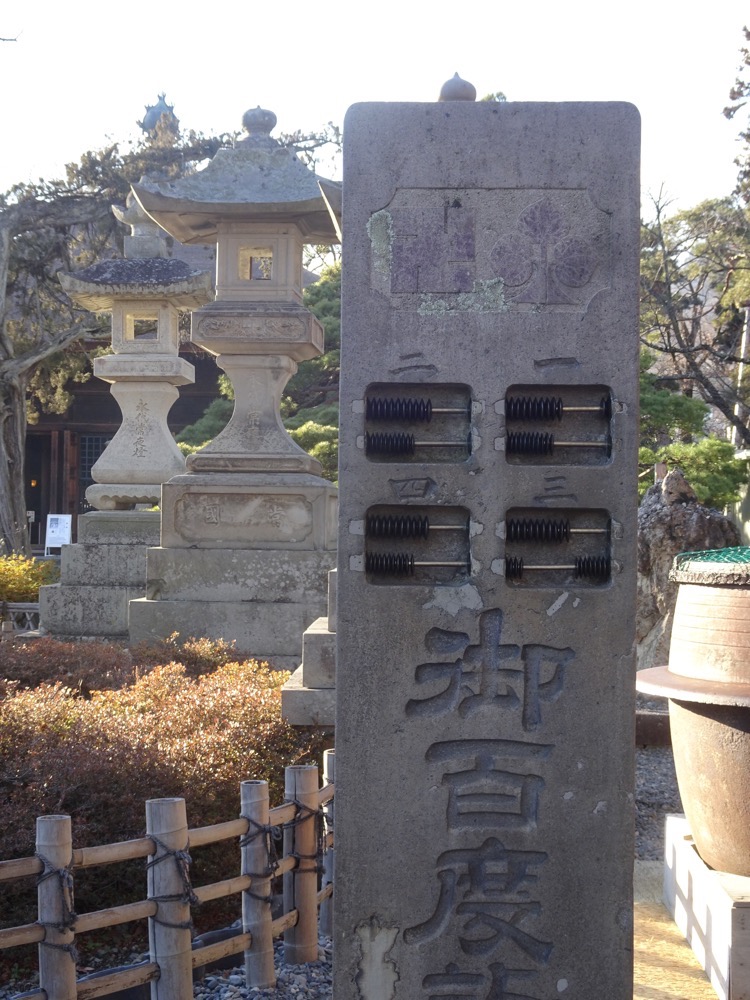
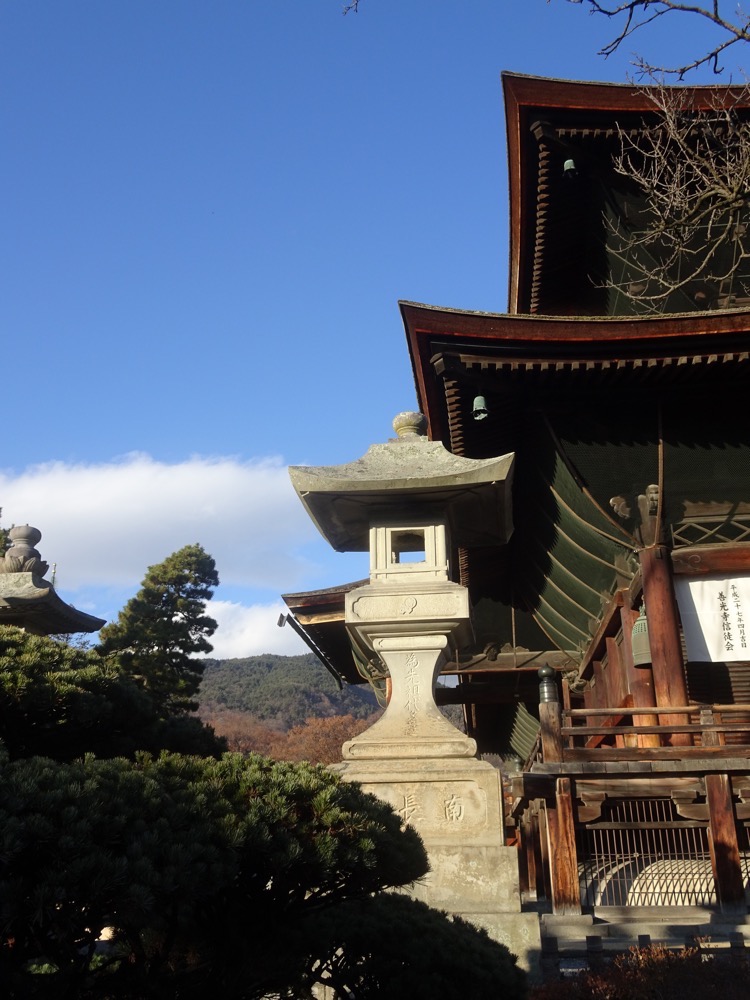
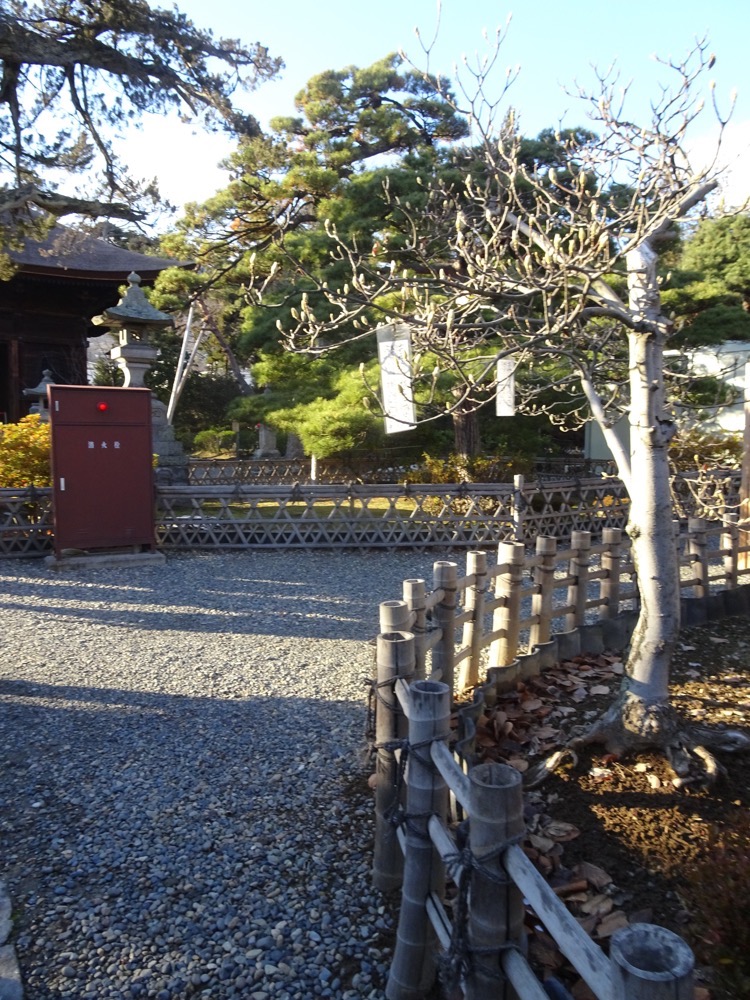 This prayer wheel had many characters engraved into it but over the centuries has been largely worn smooth. Observants would touch the prayer wheel to feel the characters of their prayers and spin the wheel to pray before the temple.
This prayer wheel had many characters engraved into it but over the centuries has been largely worn smooth. Observants would touch the prayer wheel to feel the characters of their prayers and spin the wheel to pray before the temple. 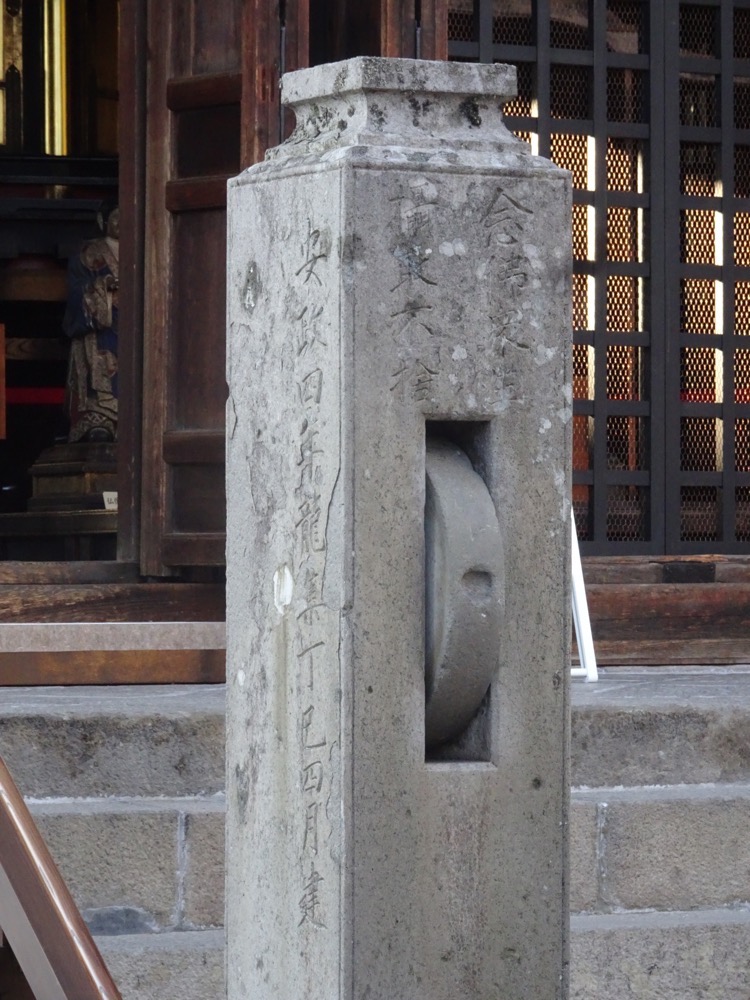 Within the temple district is this one Shinto shrine – the Japanese tend to be born as Shinto, marry as Shinto and/or as Christians (they like the big white fluffy princess wedding dresses!) but they die and have their funerals at Buddhist temples surrounded by the ideas of rebirth into the next life.
Within the temple district is this one Shinto shrine – the Japanese tend to be born as Shinto, marry as Shinto and/or as Christians (they like the big white fluffy princess wedding dresses!) but they die and have their funerals at Buddhist temples surrounded by the ideas of rebirth into the next life.
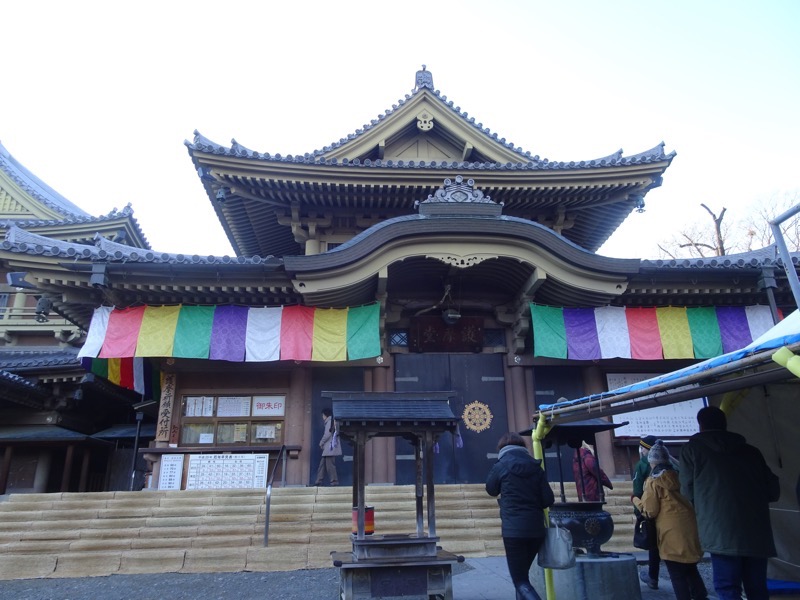 At this shrine was rows and rows of little men standing only about four inches tall, that all have the names of important ancestors in history on them. People come and search the racks for their own names, and leave small offerings (in the form of beaded necklaces for the little statues) to honour their family ancestors.
At this shrine was rows and rows of little men standing only about four inches tall, that all have the names of important ancestors in history on them. People come and search the racks for their own names, and leave small offerings (in the form of beaded necklaces for the little statues) to honour their family ancestors.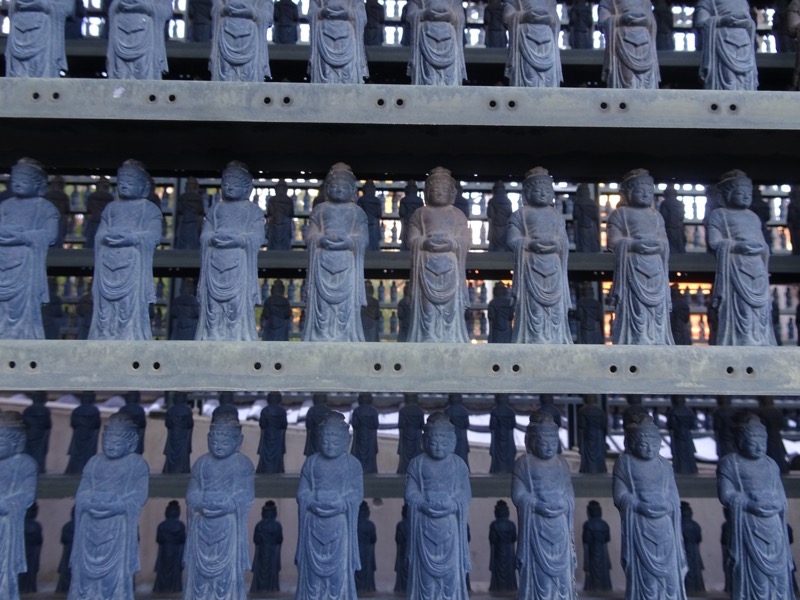
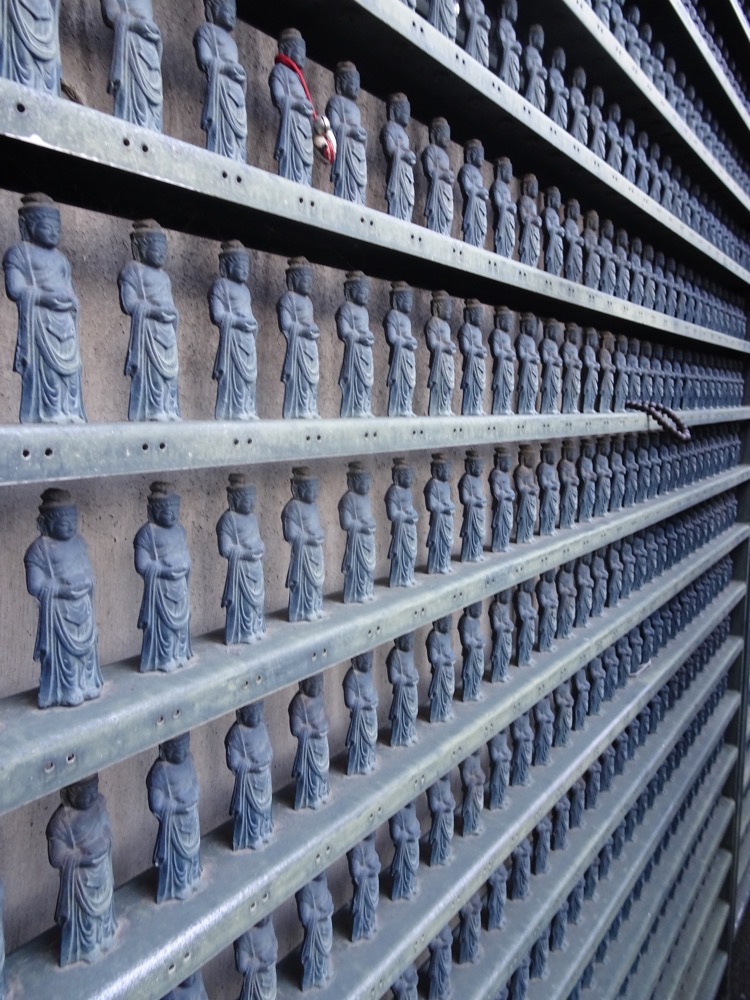 The other shrine dedicated to children who have passed away – this one is much more widely used and is more popular for some reason. It is surrounded by offerings made by mourning parents who wish to send their children into the afterlife with tokens, such as toys or clothing items.
The other shrine dedicated to children who have passed away – this one is much more widely used and is more popular for some reason. It is surrounded by offerings made by mourning parents who wish to send their children into the afterlife with tokens, such as toys or clothing items. 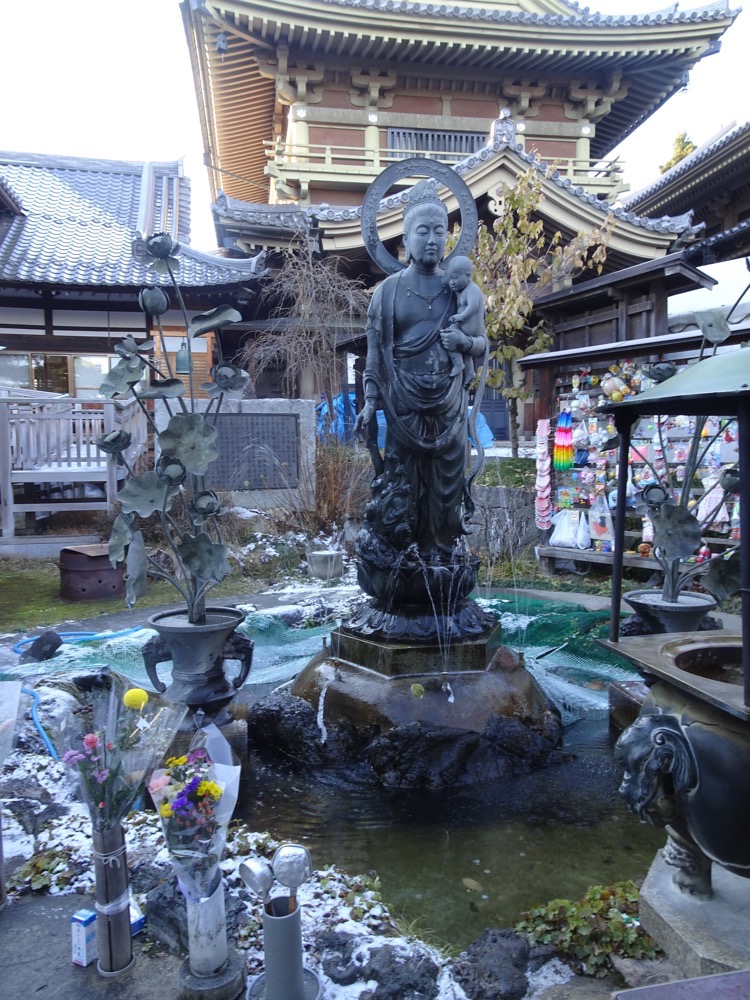 After we visited the temple, we made our way to a nearby sake brewery. Where we were treated to a sake tasting of 6 different varieties of sake, three varieties of amazuke and some really unusual sparkling yuzu sake. A very welcome warming of the cockles after a day in the cold. 🙂
After we visited the temple, we made our way to a nearby sake brewery. Where we were treated to a sake tasting of 6 different varieties of sake, three varieties of amazuke and some really unusual sparkling yuzu sake. A very welcome warming of the cockles after a day in the cold. 🙂 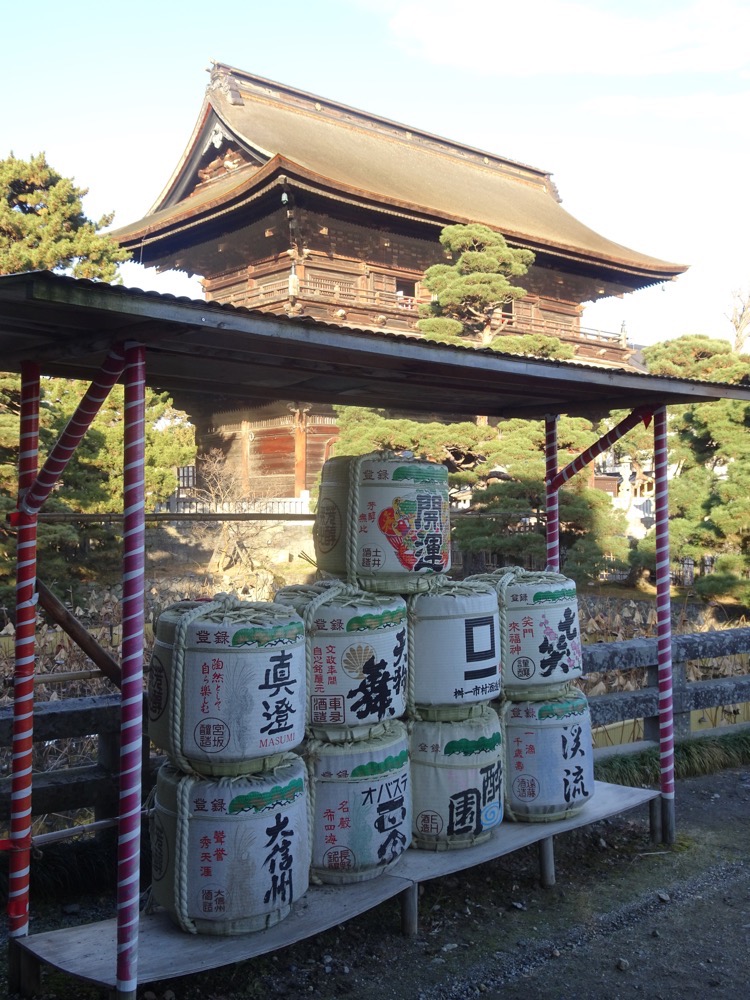
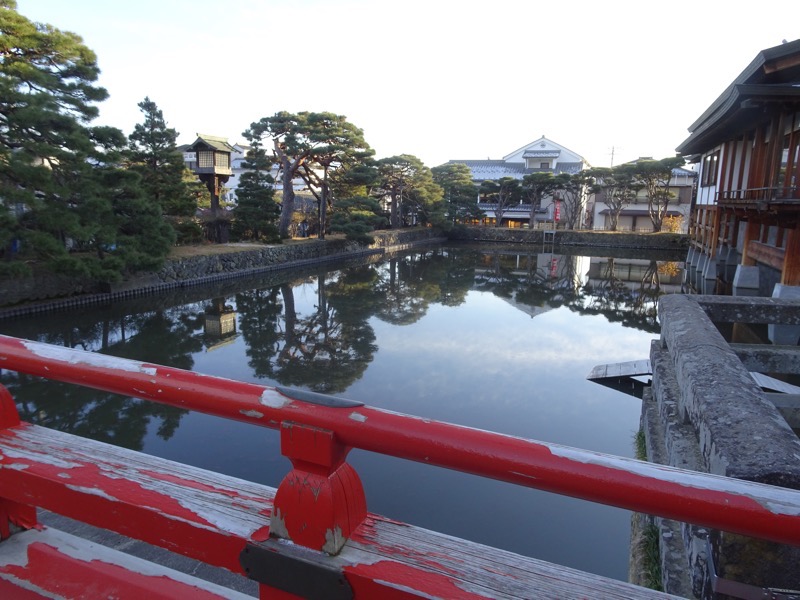
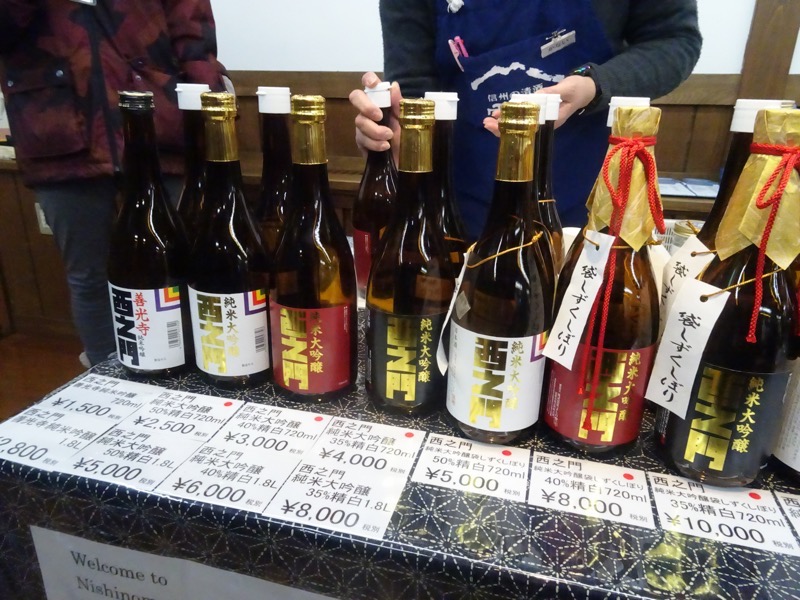
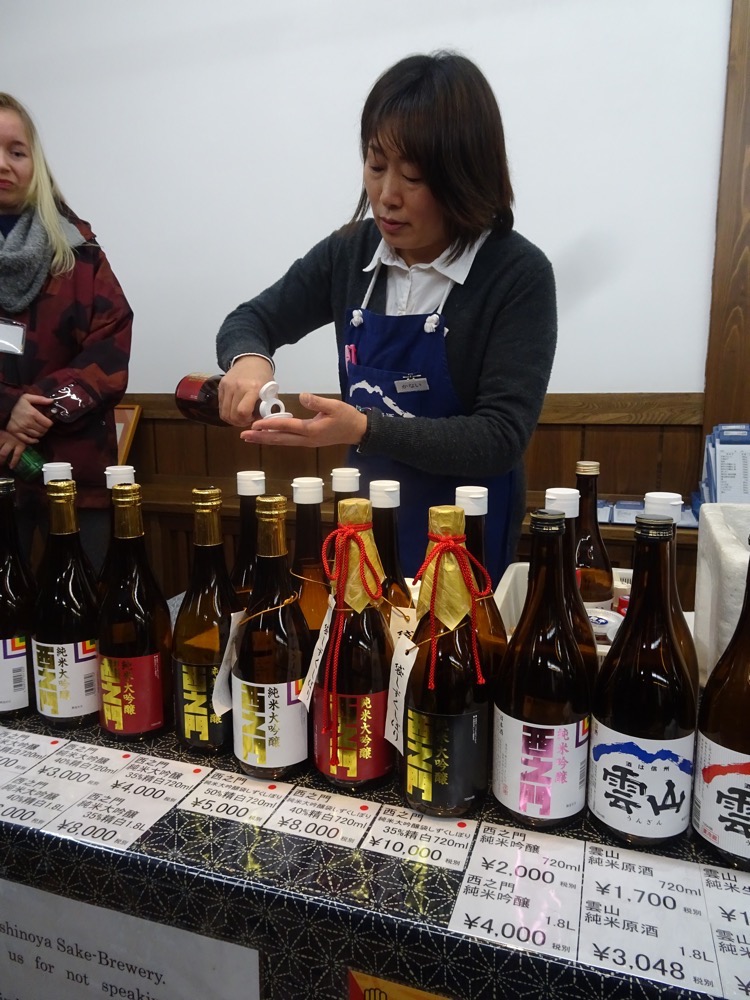
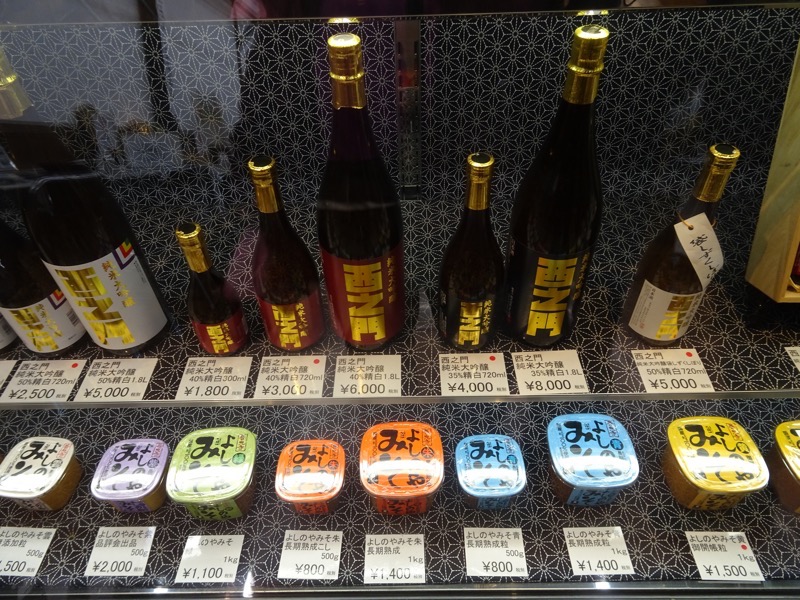 After that it was back to Nagano Station to hightail it back to Tokyo Station on the amazing (I want one!) bullet trains. I seriously love these trains, so fast, so clean, lots of leg room, power points, a lovely lady with a tea trolley and before you know it – you are at your destination.
After that it was back to Nagano Station to hightail it back to Tokyo Station on the amazing (I want one!) bullet trains. I seriously love these trains, so fast, so clean, lots of leg room, power points, a lovely lady with a tea trolley and before you know it – you are at your destination.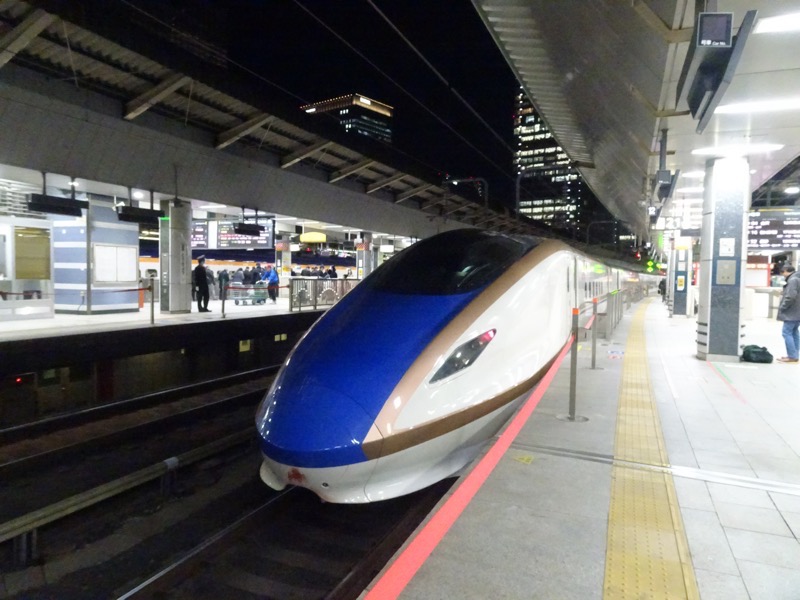
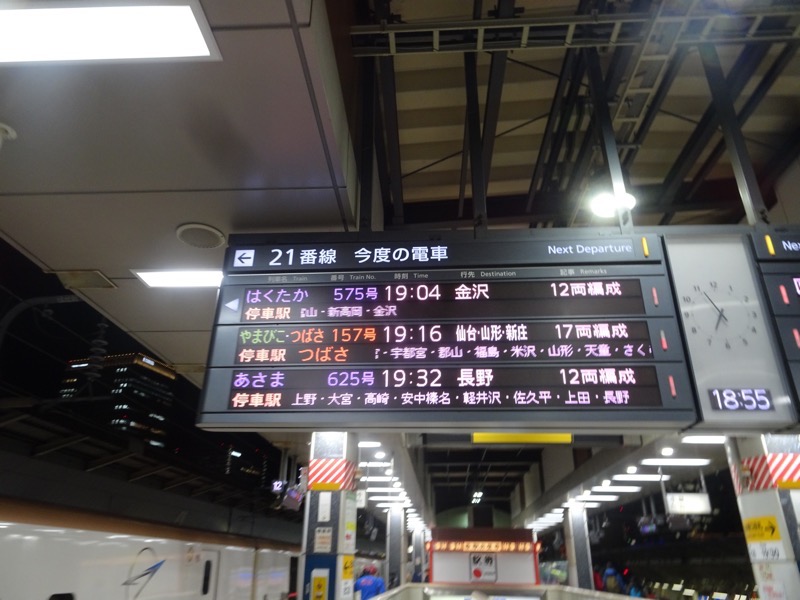 We then made our way back to Shinjuku for a bit of late night shopping (Shell, if you are reading this, I have stocked up on sunscreen!), and a bite to eat at a cheerful little ramen restaurant.
We then made our way back to Shinjuku for a bit of late night shopping (Shell, if you are reading this, I have stocked up on sunscreen!), and a bite to eat at a cheerful little ramen restaurant. 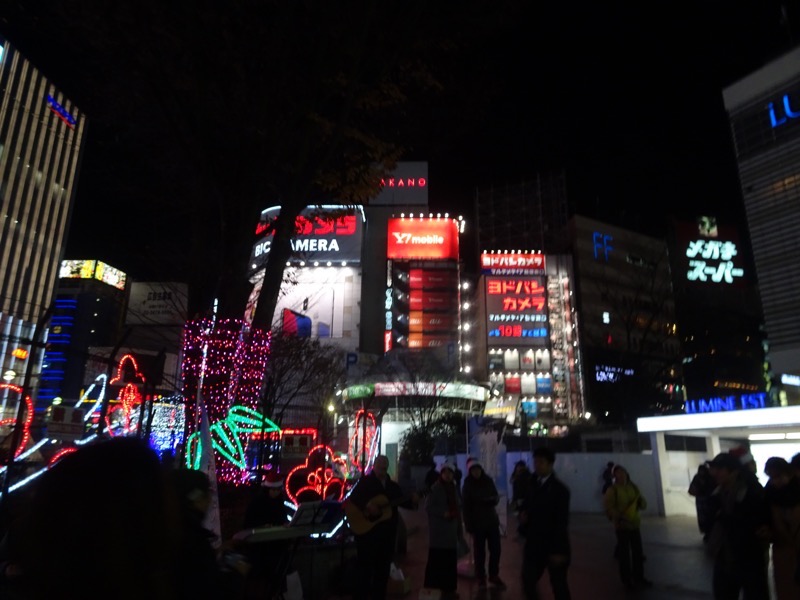 Found what appeared to be the Attagirl outlet store – no knee pads though… #confused
Found what appeared to be the Attagirl outlet store – no knee pads though… #confused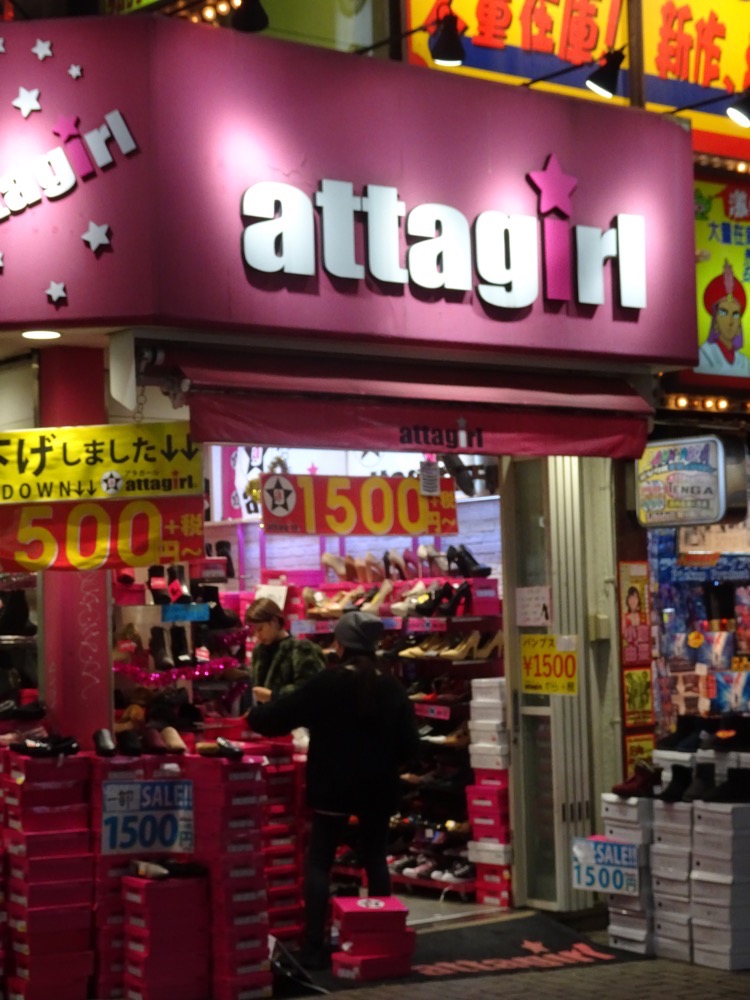
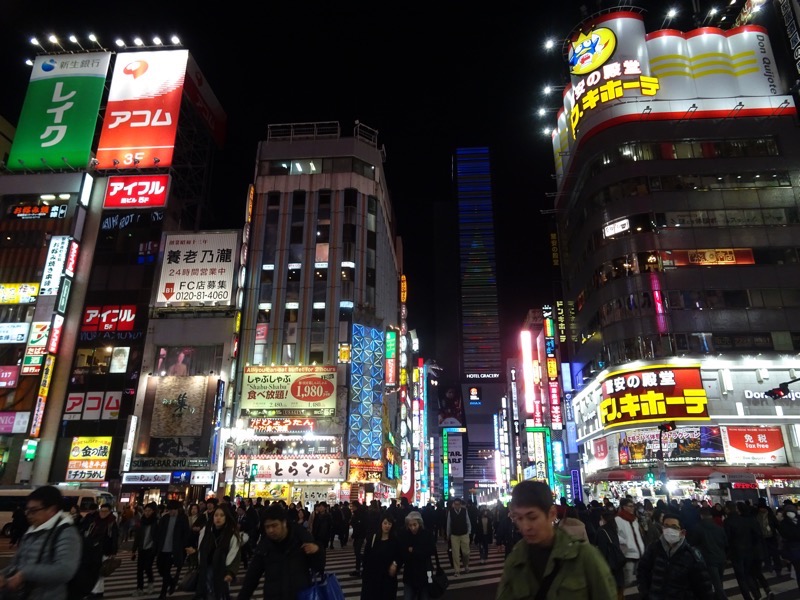 Shinjuku is really quite lively any time of the day – but at night time it really seems to come alive and is transformed into the Tokyo we have all become familiar with from movies and tv. People are everywhere, the lights of the advertising don’t just rival Times Square in New York, but completely eclipse it. The atmosphere here at the momen is just electric – everyone is cheerful and doing their Christmas shopping and carols are steaming out of all the stores. It’s been a huge day, so after our shopping/dinner in Shinjuku it was back to the hotel for another well deserved soak in the tub!
Shinjuku is really quite lively any time of the day – but at night time it really seems to come alive and is transformed into the Tokyo we have all become familiar with from movies and tv. People are everywhere, the lights of the advertising don’t just rival Times Square in New York, but completely eclipse it. The atmosphere here at the momen is just electric – everyone is cheerful and doing their Christmas shopping and carols are steaming out of all the stores. It’s been a huge day, so after our shopping/dinner in Shinjuku it was back to the hotel for another well deserved soak in the tub!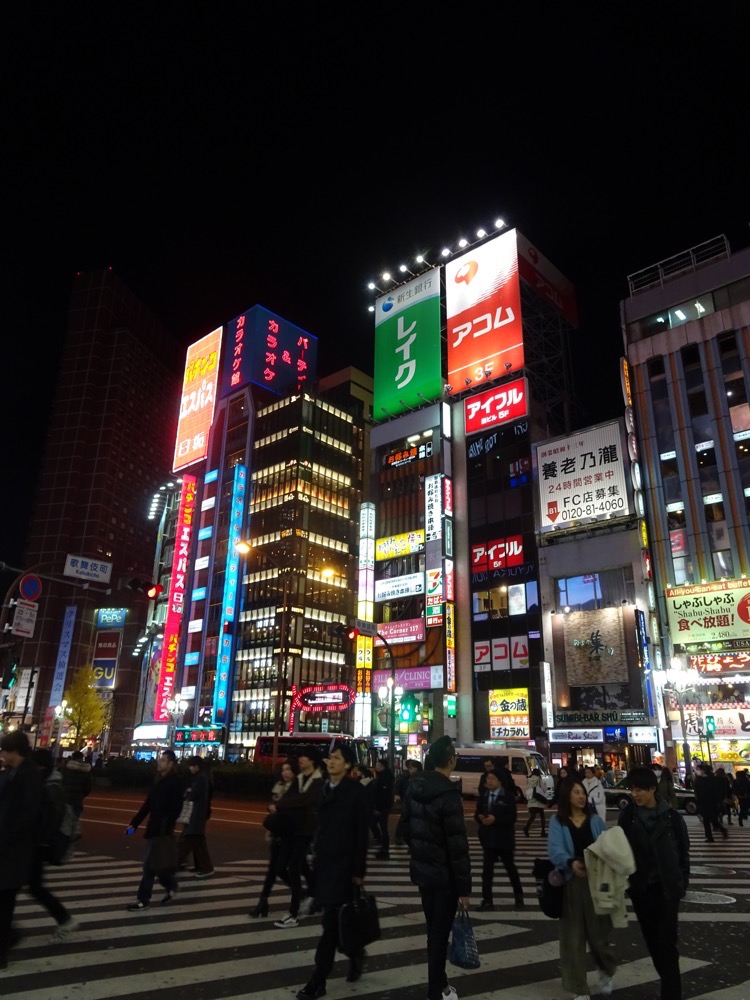
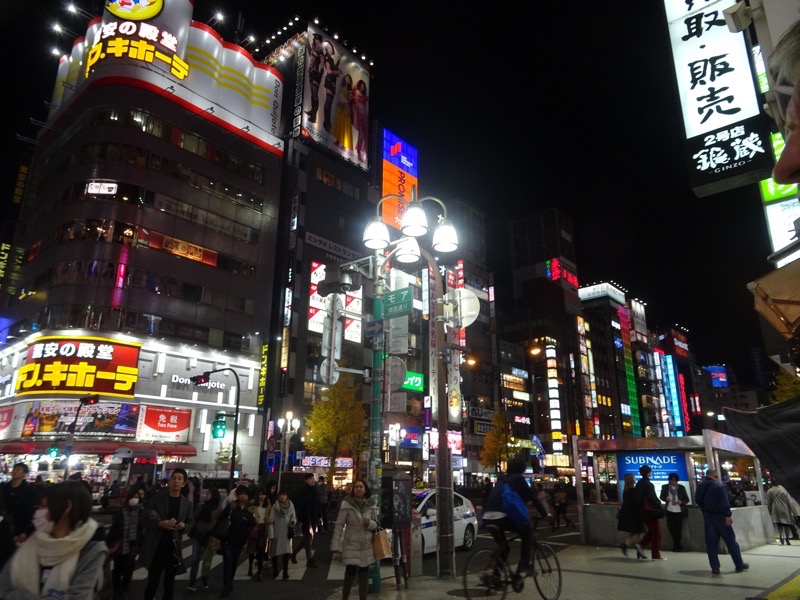 The
The
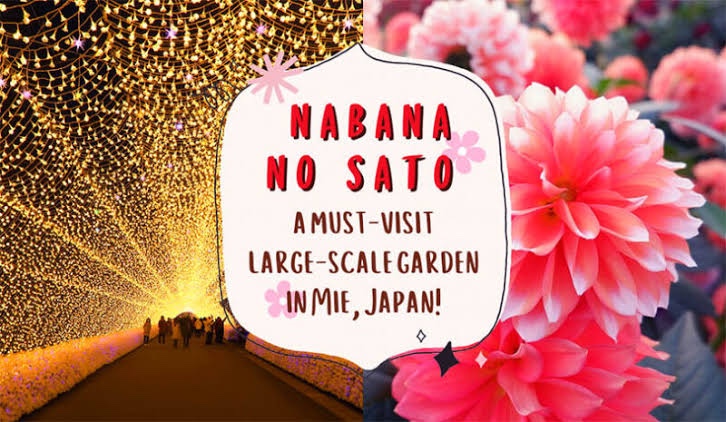 The Nabano no Sato illuminated gardens are a ‘must visit’ when in Nagano so I figured we needed to go visit. Given it was all happening after hours, it wasn’t too hard to set aside the evening to go out and see them. The gardens are actually attached to an enormous plant nursery and they have been lighting up paths and expanding on the attraction for years. At 2500JPY per person for the entrance fee, it’s not so cheap to just wander around and look at the lights, but it weirdly includes 1000JPY per person in vouchers that you can spend inside the park…
The Nabano no Sato illuminated gardens are a ‘must visit’ when in Nagano so I figured we needed to go visit. Given it was all happening after hours, it wasn’t too hard to set aside the evening to go out and see them. The gardens are actually attached to an enormous plant nursery and they have been lighting up paths and expanding on the attraction for years. At 2500JPY per person for the entrance fee, it’s not so cheap to just wander around and look at the lights, but it weirdly includes 1000JPY per person in vouchers that you can spend inside the park… 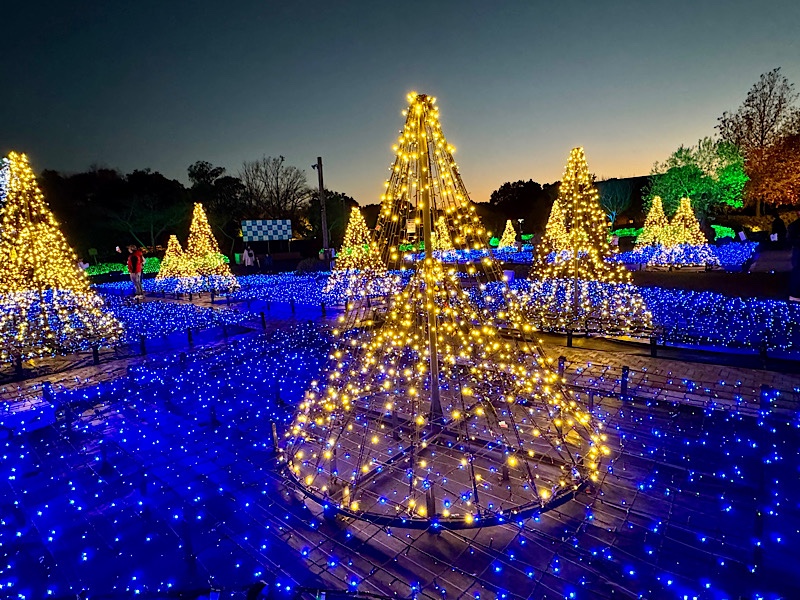
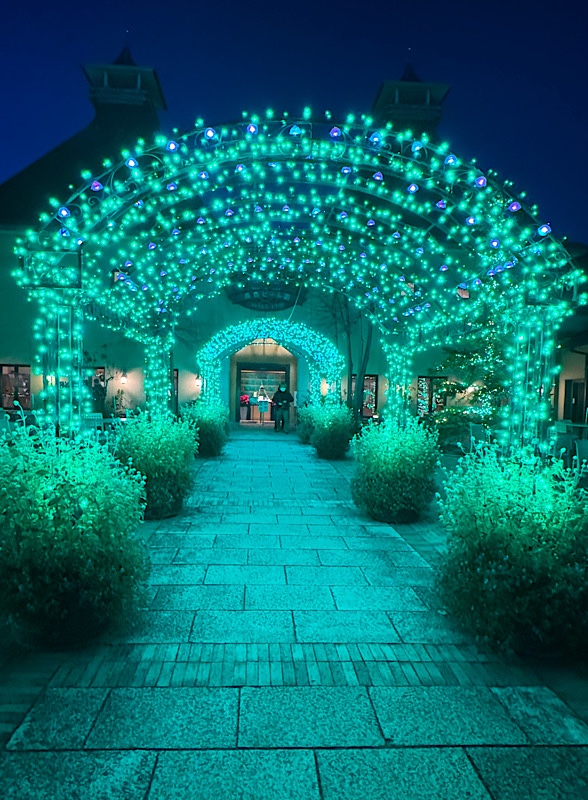 Having read up on the place before coming out here, we arrived just before sunset and had a bite to eat- from what I’ve read and now from what I’ve seen, if you go wander through the park first if you want something to eat a bit later, you’ll be lining up for ages to get seated in any of the park’s restaurants. The place was BUSY – and the 5400 space car park was no where near full.
Having read up on the place before coming out here, we arrived just before sunset and had a bite to eat- from what I’ve read and now from what I’ve seen, if you go wander through the park first if you want something to eat a bit later, you’ll be lining up for ages to get seated in any of the park’s restaurants. The place was BUSY – and the 5400 space car park was no where near full.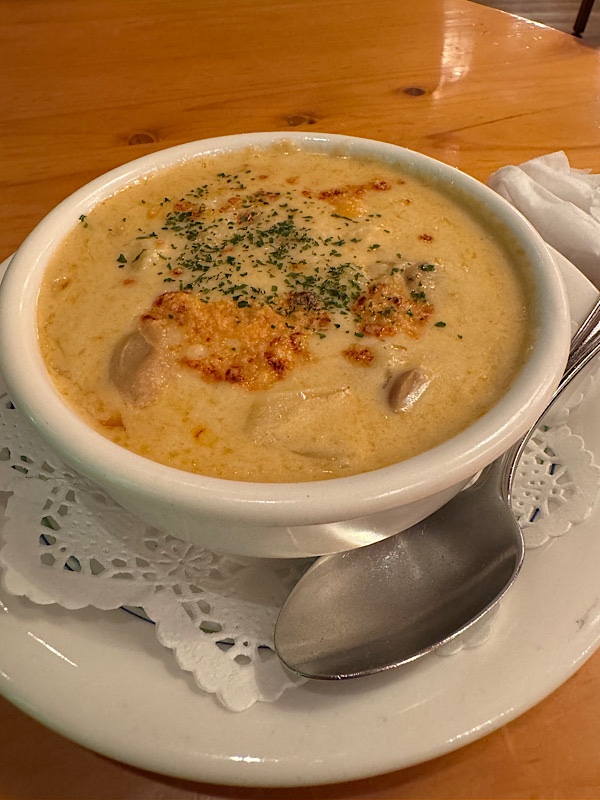 Mr K ordered a park katsu curry that was served in a huge cube of bread with a miso curry and egg. The curry was really tasty… miso curry is a popular thing in the Nagano region.
Mr K ordered a park katsu curry that was served in a huge cube of bread with a miso curry and egg. The curry was really tasty… miso curry is a popular thing in the Nagano region.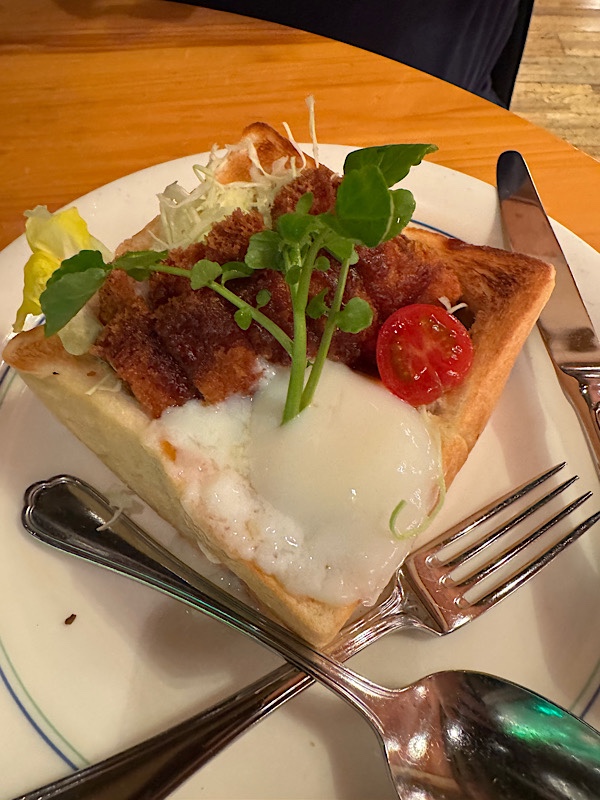 I also ordered some saké – because well, every time I look at a menu and there are no diet soft drink options, I think ‘I’ve gonna have the sugar, I may as well have the alcohol!’. This is the FIRST time ever that I have been served hot saké in Japan. Honestly, all the brewery and saké shops, and restaurants we have been to – the saké is, by default, chilled. With this one exception.
I also ordered some saké – because well, every time I look at a menu and there are no diet soft drink options, I think ‘I’ve gonna have the sugar, I may as well have the alcohol!’. This is the FIRST time ever that I have been served hot saké in Japan. Honestly, all the brewery and saké shops, and restaurants we have been to – the saké is, by default, chilled. With this one exception. 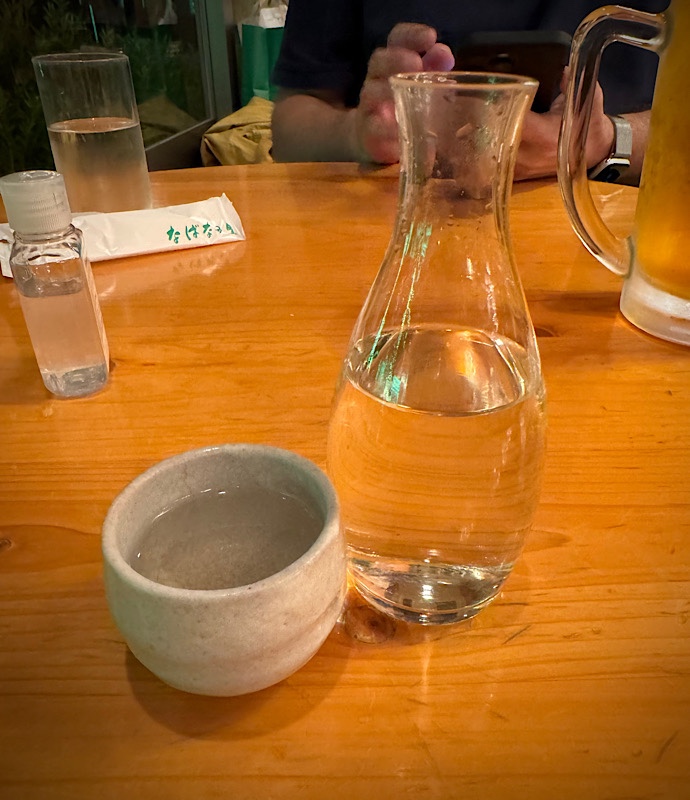 Which got me wondering why…
Which got me wondering why… 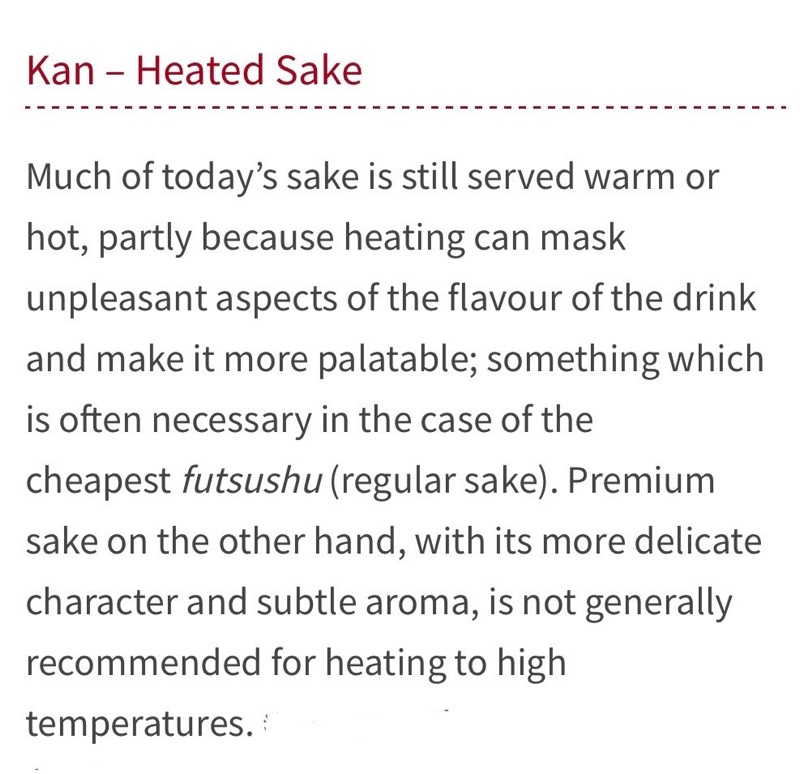 I actually asked for some ice to cool it down and see what it tasted like, as while it was hot all I could pick out was the heavy tone of ‘this is alcohol’… and yeah, it was not sweet, not dry, not citrusy, not floral, it was just kinda bland. So I can see why they heated it up.
I actually asked for some ice to cool it down and see what it tasted like, as while it was hot all I could pick out was the heavy tone of ‘this is alcohol’… and yeah, it was not sweet, not dry, not citrusy, not floral, it was just kinda bland. So I can see why they heated it up. 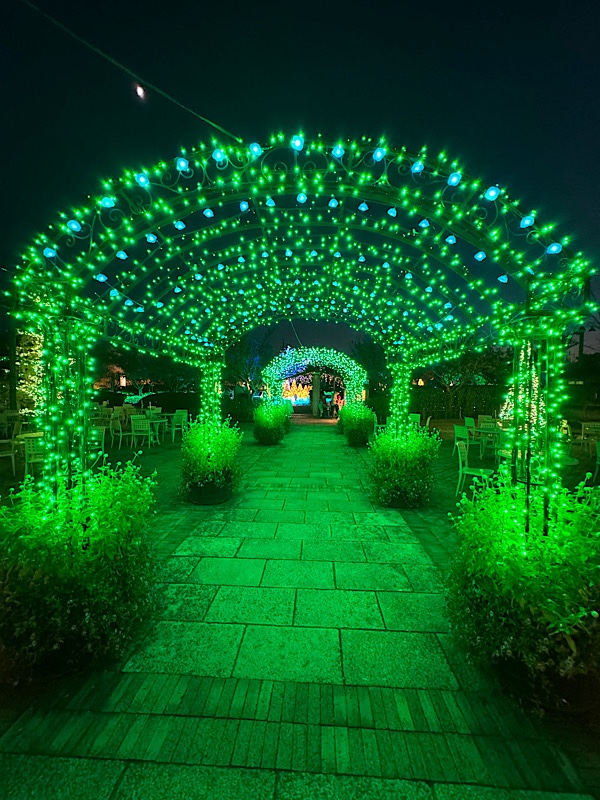 Through the large park is an enormous stream of hot onsen water lined with beautiful Japanese maple trees. There was a public onsen for bathing if that took your fancy, as well as further in a very popular onsen foot bath which had crowds of people using it. The stream made for some glorious opportunities for reflection photographs. But it was very hard to capture the beauty of the scene…
Through the large park is an enormous stream of hot onsen water lined with beautiful Japanese maple trees. There was a public onsen for bathing if that took your fancy, as well as further in a very popular onsen foot bath which had crowds of people using it. The stream made for some glorious opportunities for reflection photographs. But it was very hard to capture the beauty of the scene… 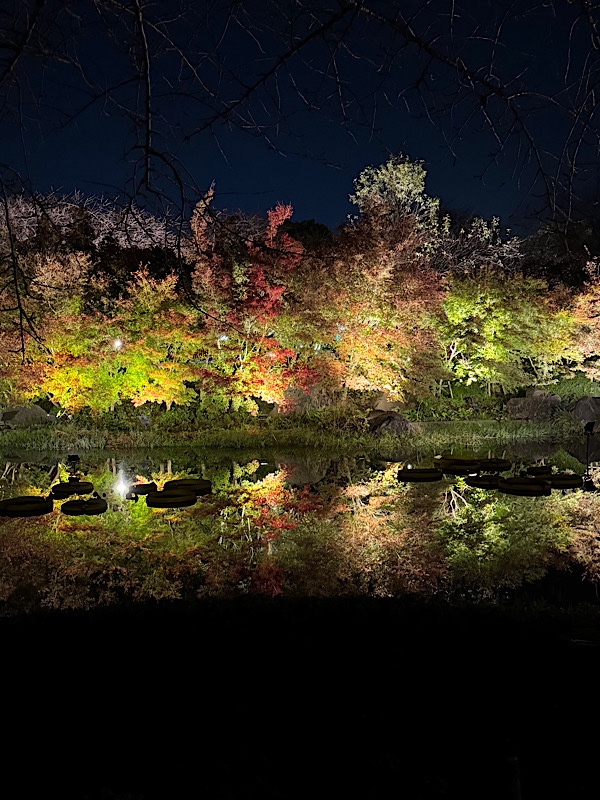 Though I repeatedly tried to! So many photos of the same subject. 🙂
Though I repeatedly tried to! So many photos of the same subject. 🙂 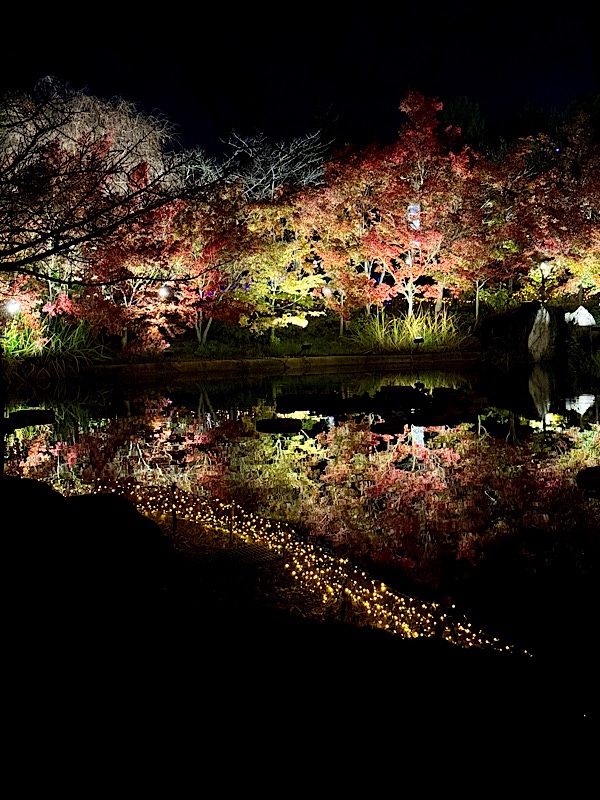 There was also an enormous lake which led up to what looked like a Christian church – an yes, you can have weddings out here, or just come out and having wedding photos taken in the park. It’s popular all year round for the autumn leaves and also for the cherry blossoms and massive begonia fields.
There was also an enormous lake which led up to what looked like a Christian church – an yes, you can have weddings out here, or just come out and having wedding photos taken in the park. It’s popular all year round for the autumn leaves and also for the cherry blossoms and massive begonia fields. 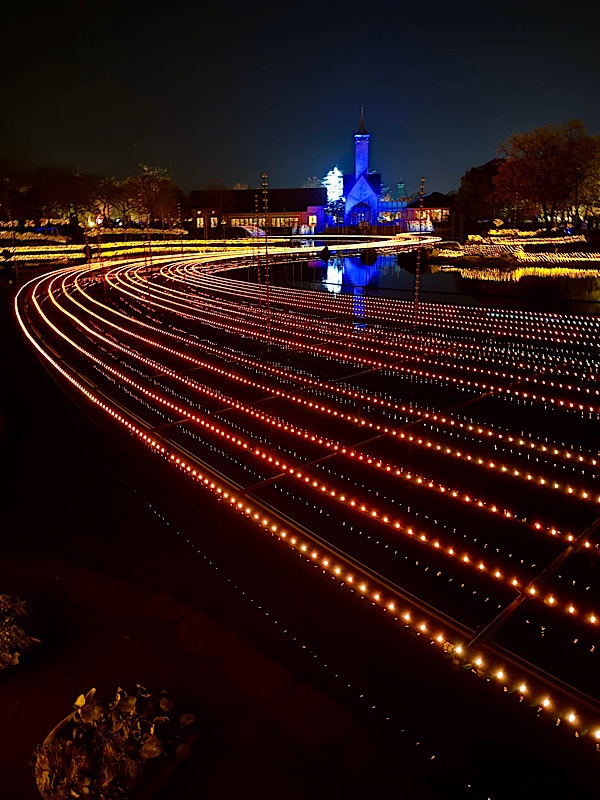 Attempt 53 at trying to captures the reflections of the autumn leaves in the lake…
Attempt 53 at trying to captures the reflections of the autumn leaves in the lake…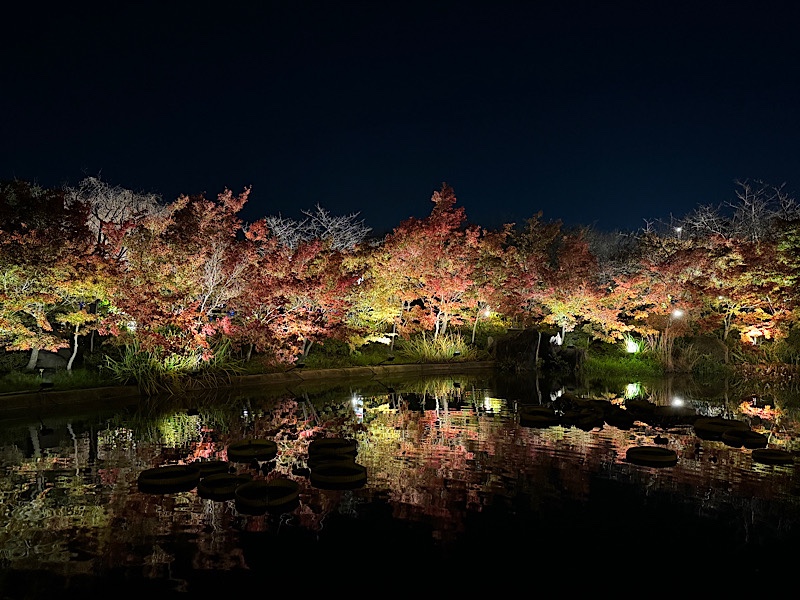
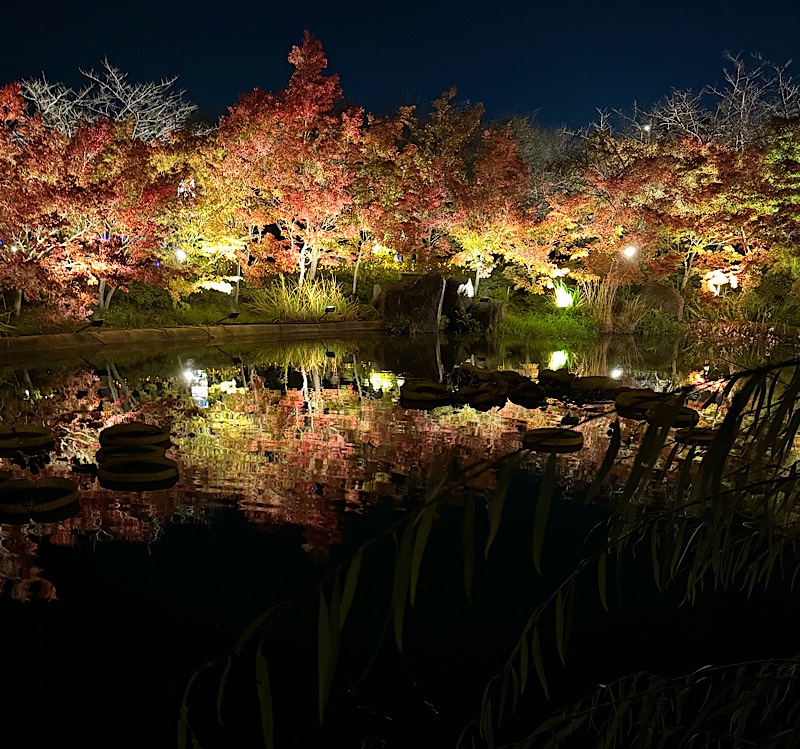
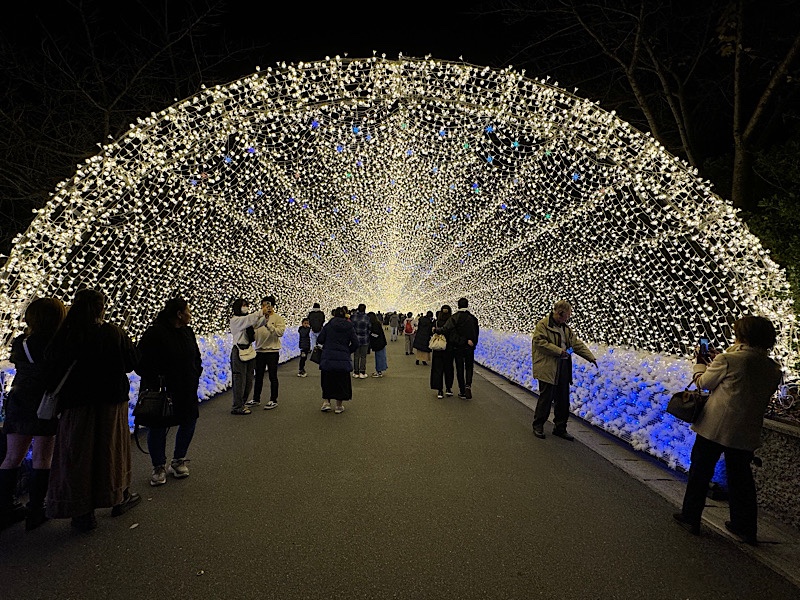
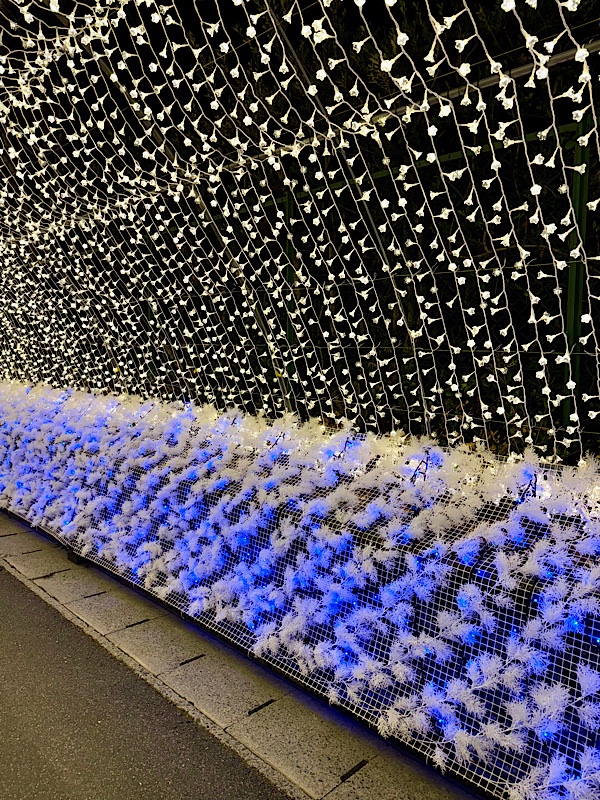
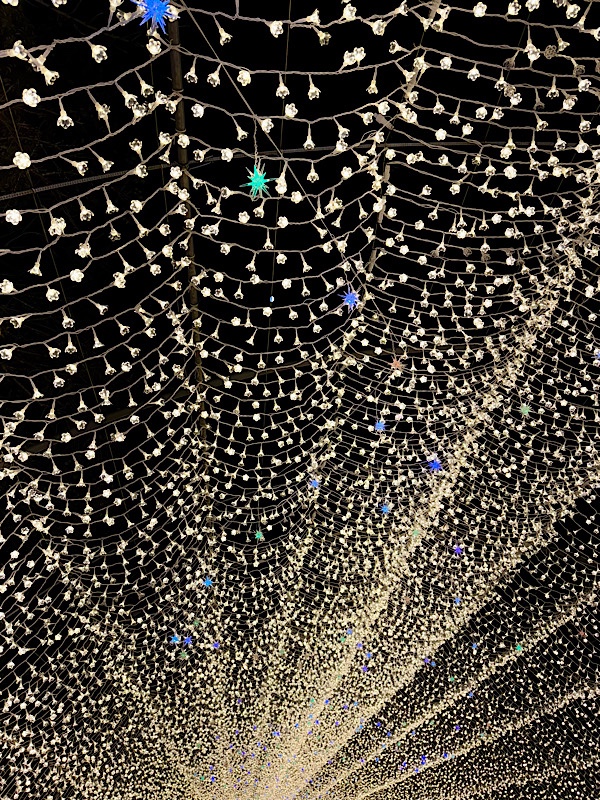
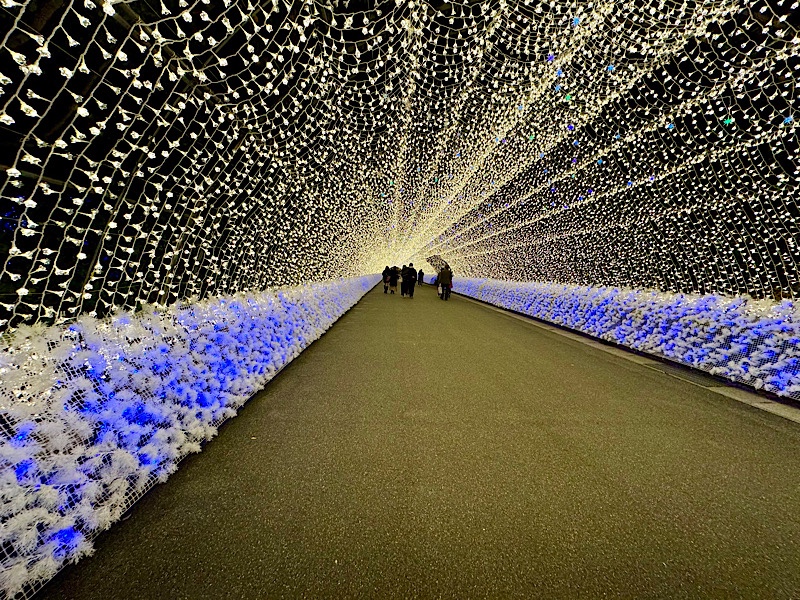 It was actually really pretty which got me wondering why the hell do people like twinkle/fairy lights so much? What bower-bird like instinct is driving this?
It was actually really pretty which got me wondering why the hell do people like twinkle/fairy lights so much? What bower-bird like instinct is driving this?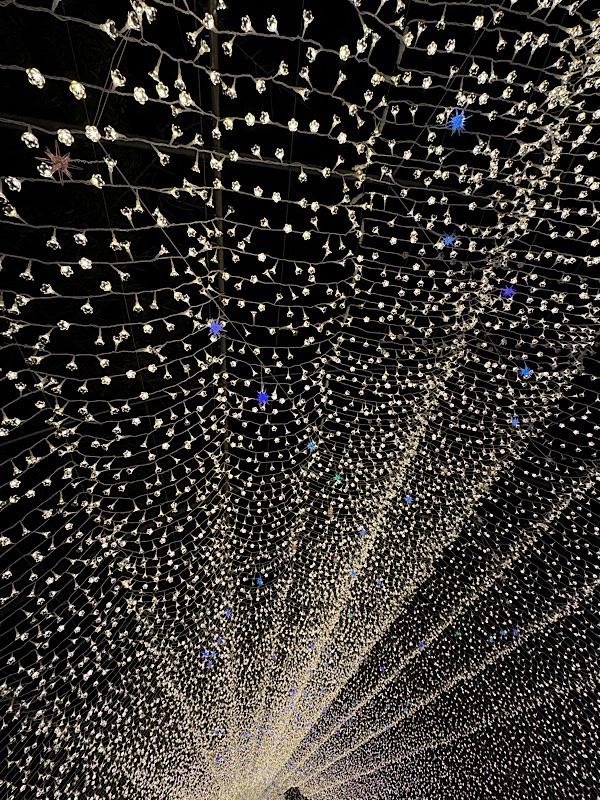
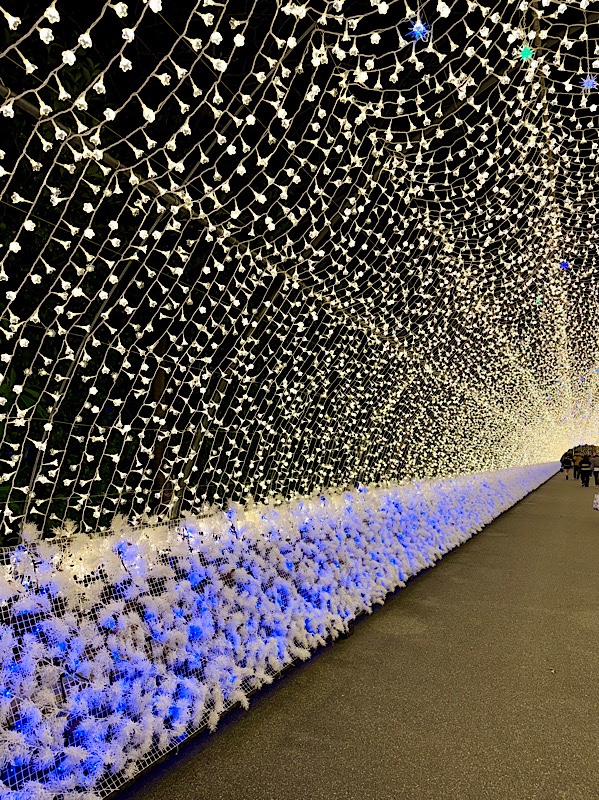
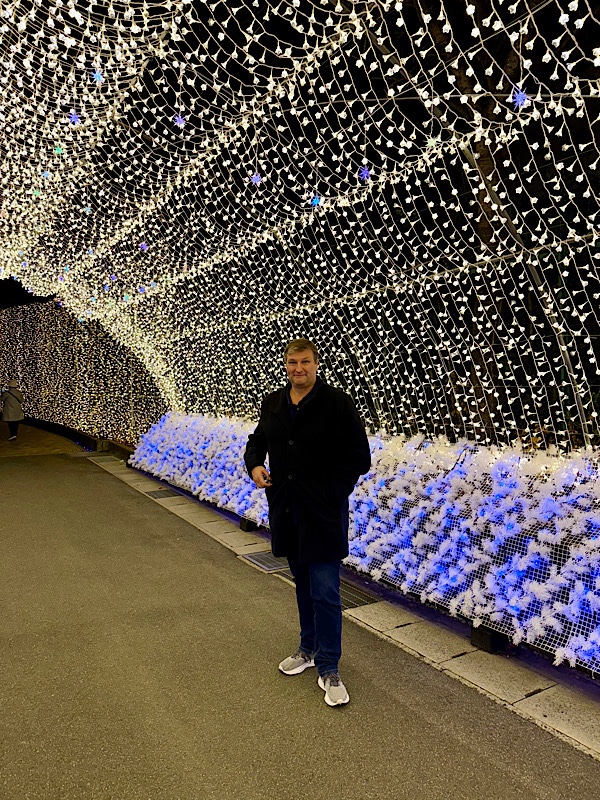
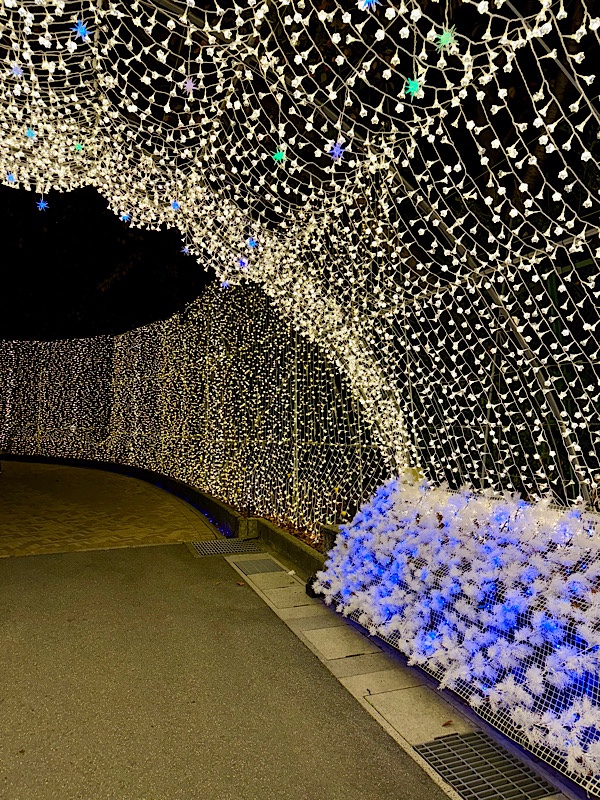 So we’re not all just a bunch of nutters flocking to a Nagoya plant nursery for no reason – we’re psychologically drawn to them. 😉 #sciencebitches
So we’re not all just a bunch of nutters flocking to a Nagoya plant nursery for no reason – we’re psychologically drawn to them. 😉 #sciencebitches 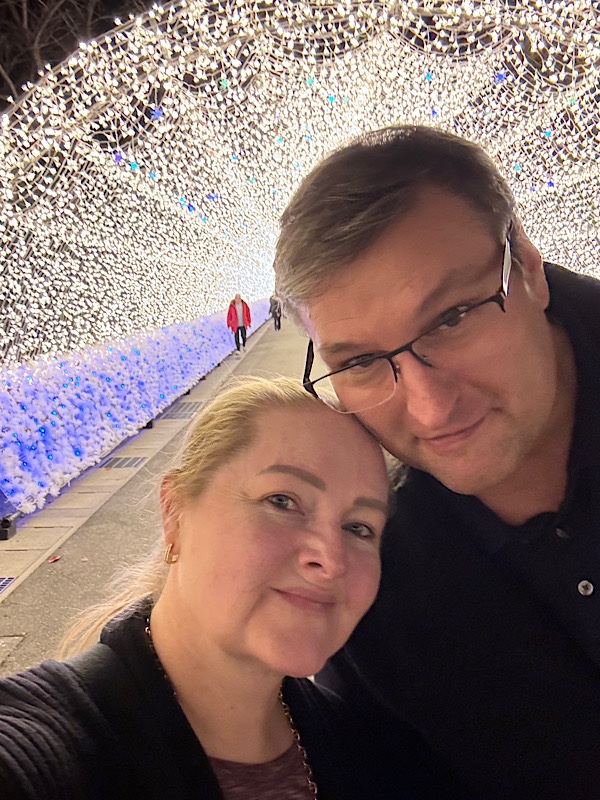
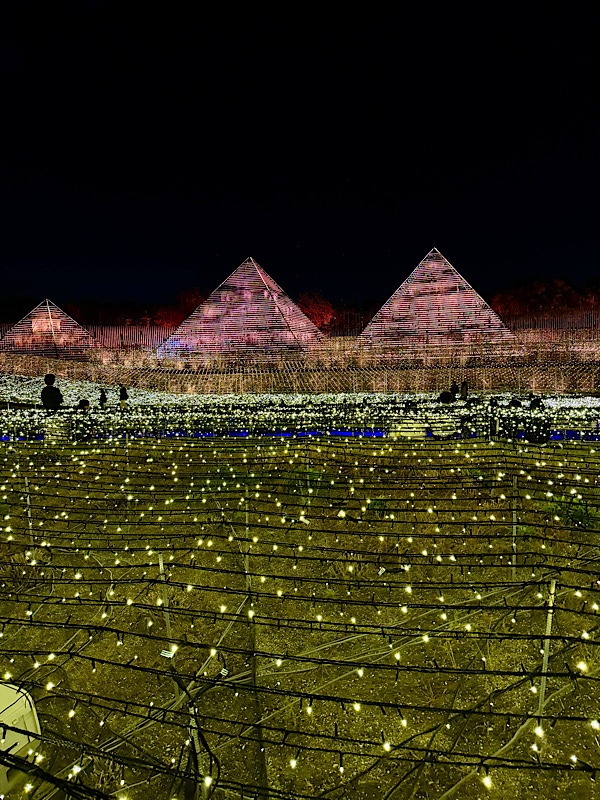
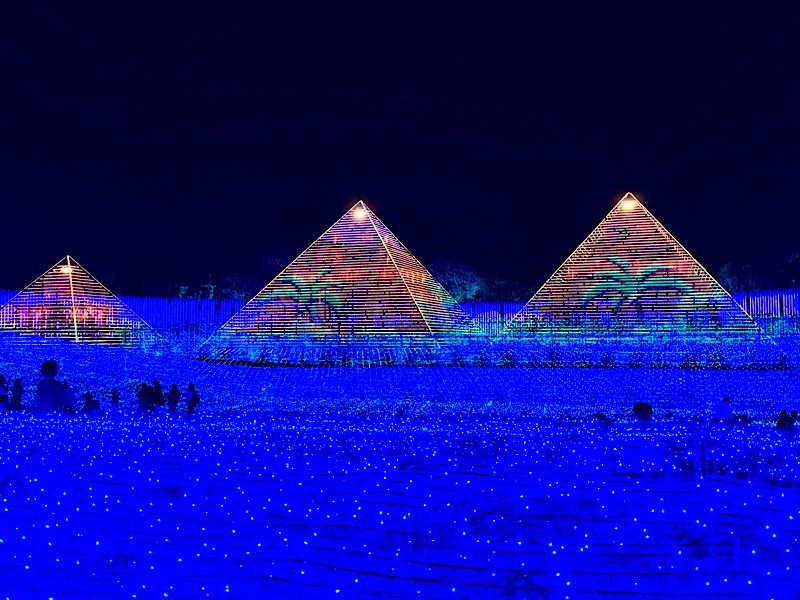
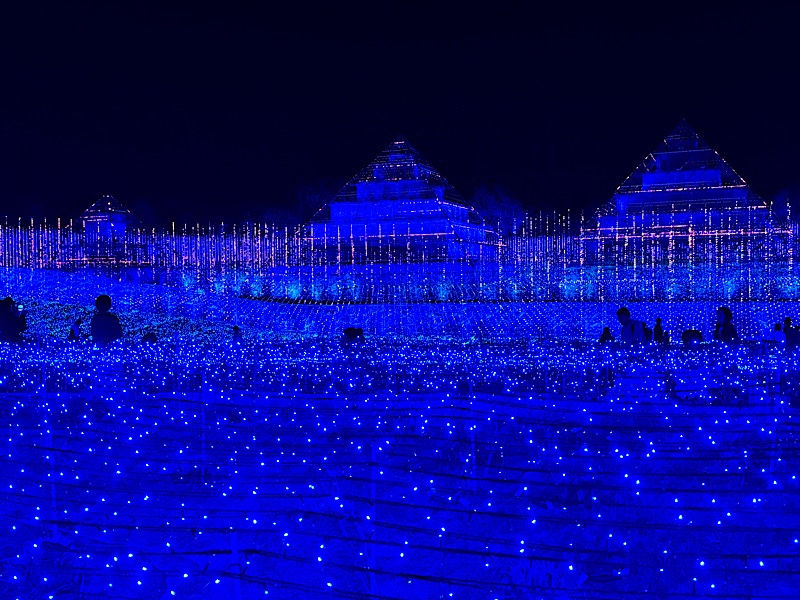
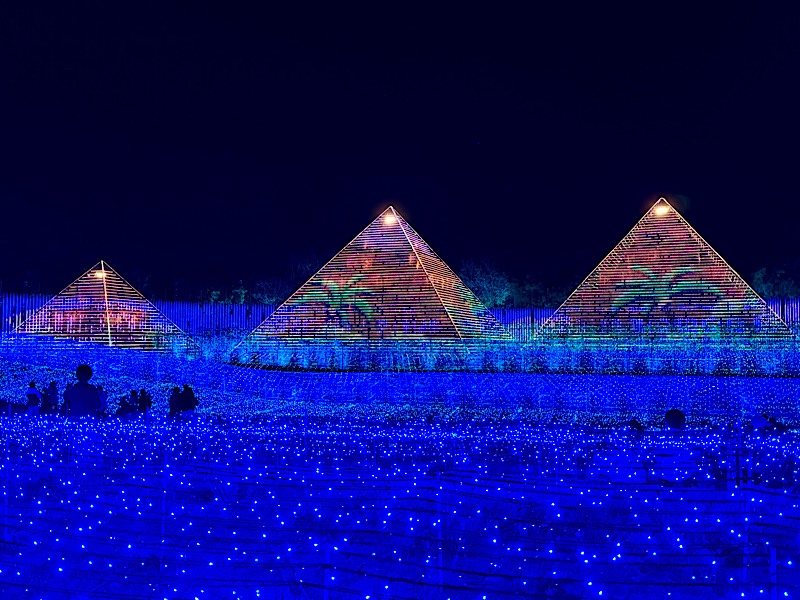
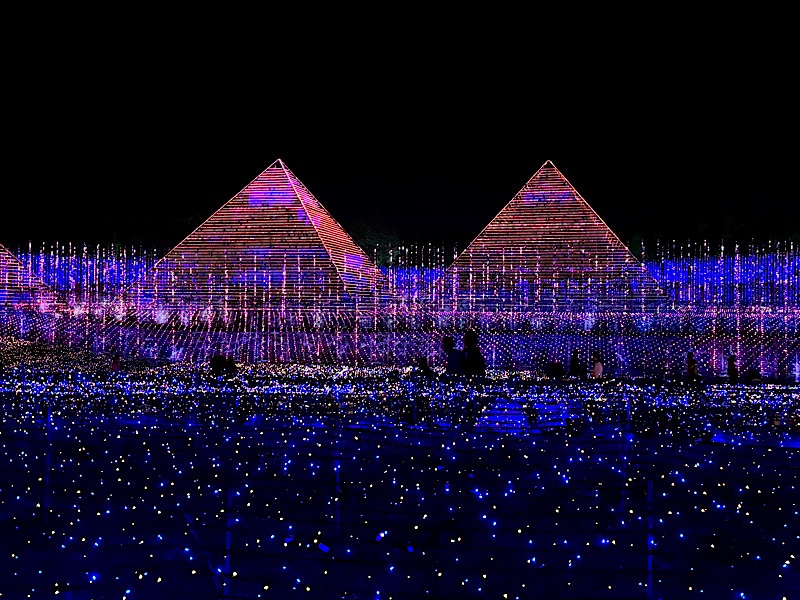
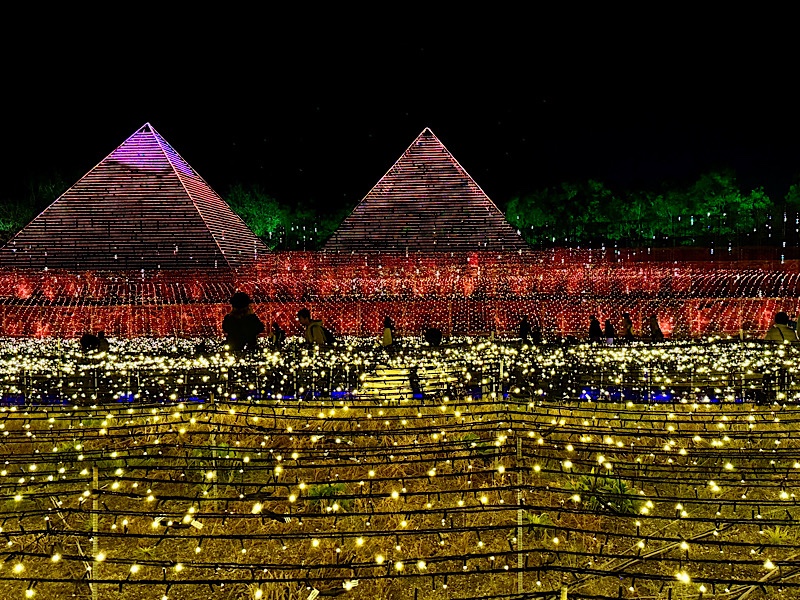 Ahhhh… a tunnel of love hearts.
Ahhhh… a tunnel of love hearts.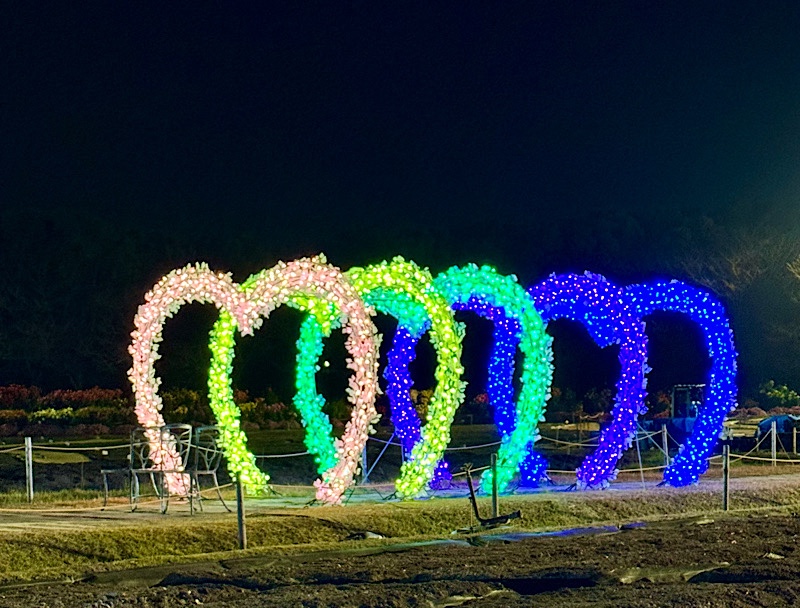 In front of which you can get a professional photograph with your sweetie.
In front of which you can get a professional photograph with your sweetie. 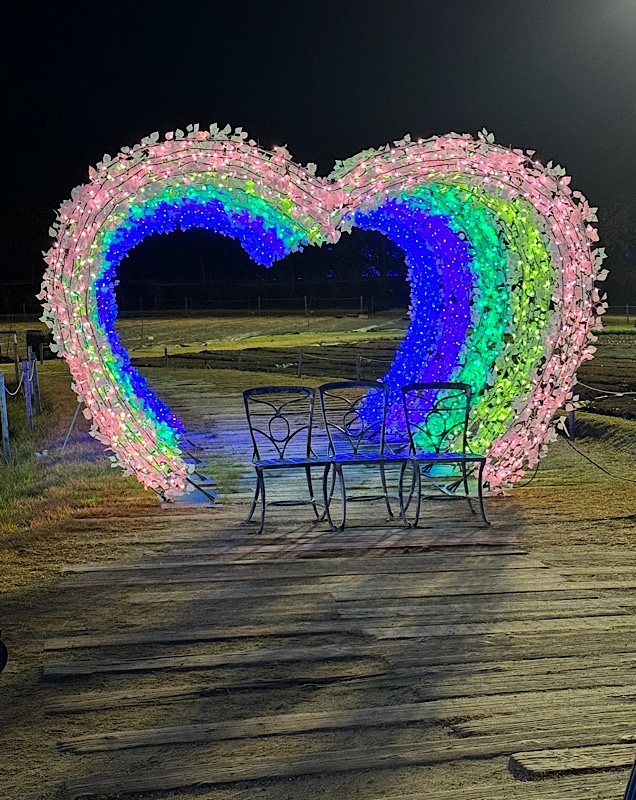 Another tunnel – this time made to look like draping wisteria.
Another tunnel – this time made to look like draping wisteria.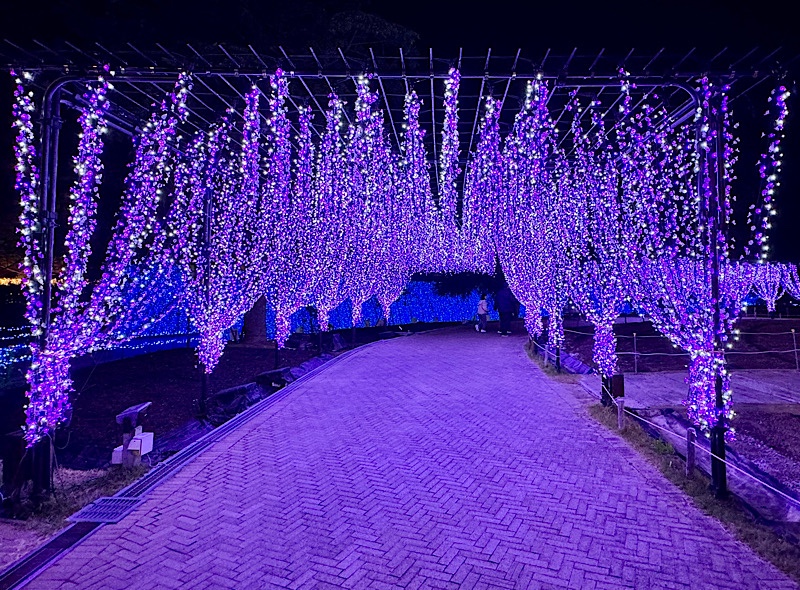 But the most adorable was for last – the long flower tunnel leading back around to the lake… there were two little boys running around with us in tiny little Santa suits. Their Mum chasing them with a large camera trying to get a Christmas photo of her little darlings. They were so excited and happy and much to excited to sit together for more than a fraction of a second for poor Mum to take their photo. They were so cute!
But the most adorable was for last – the long flower tunnel leading back around to the lake… there were two little boys running around with us in tiny little Santa suits. Their Mum chasing them with a large camera trying to get a Christmas photo of her little darlings. They were so excited and happy and much to excited to sit together for more than a fraction of a second for poor Mum to take their photo. They were so cute! 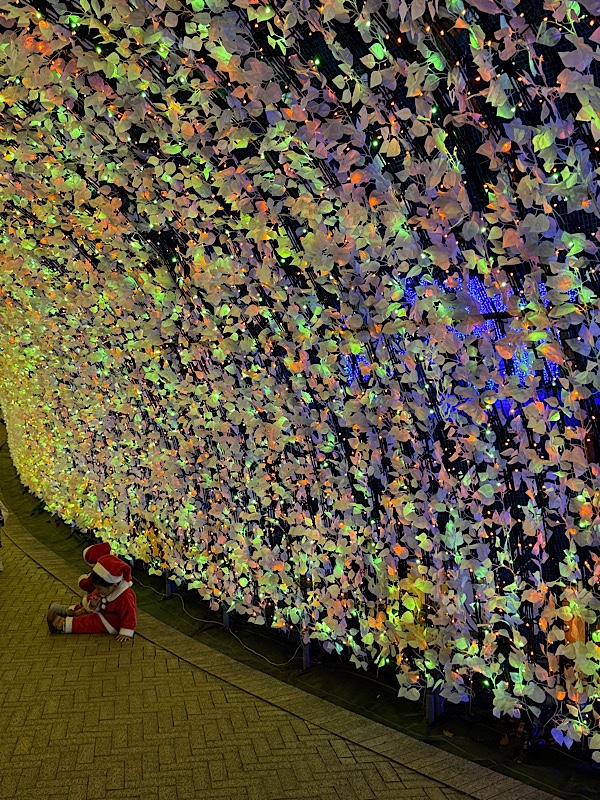
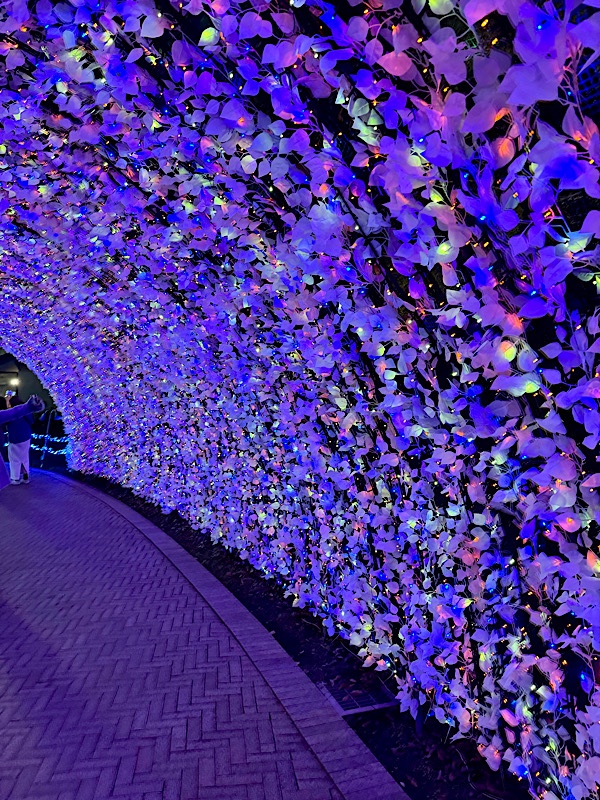
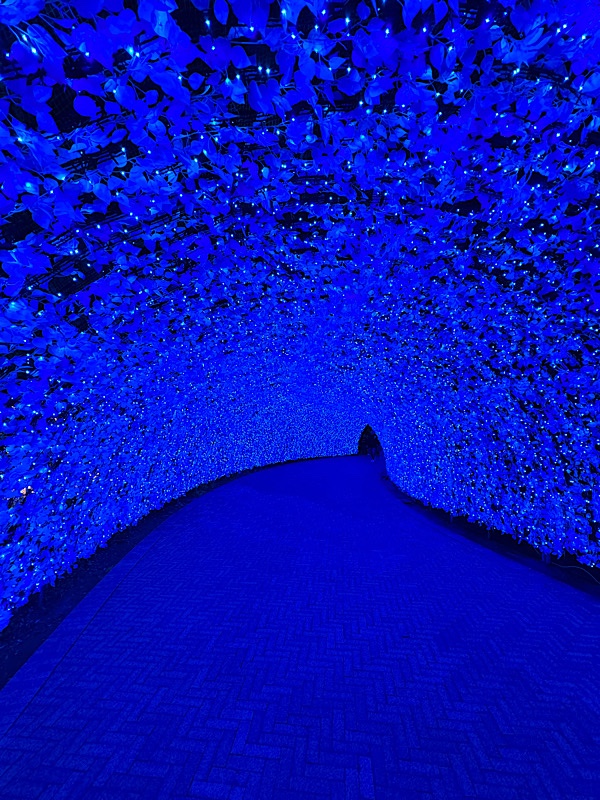 Obligatory selfie…
Obligatory selfie…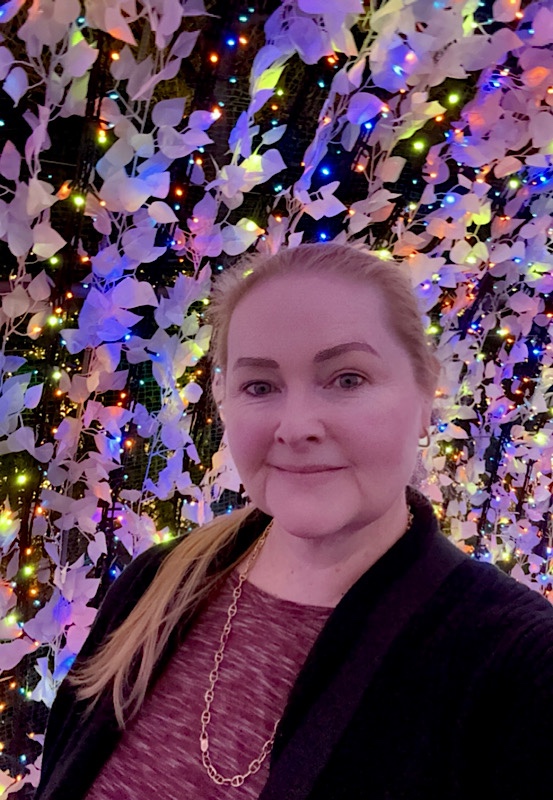
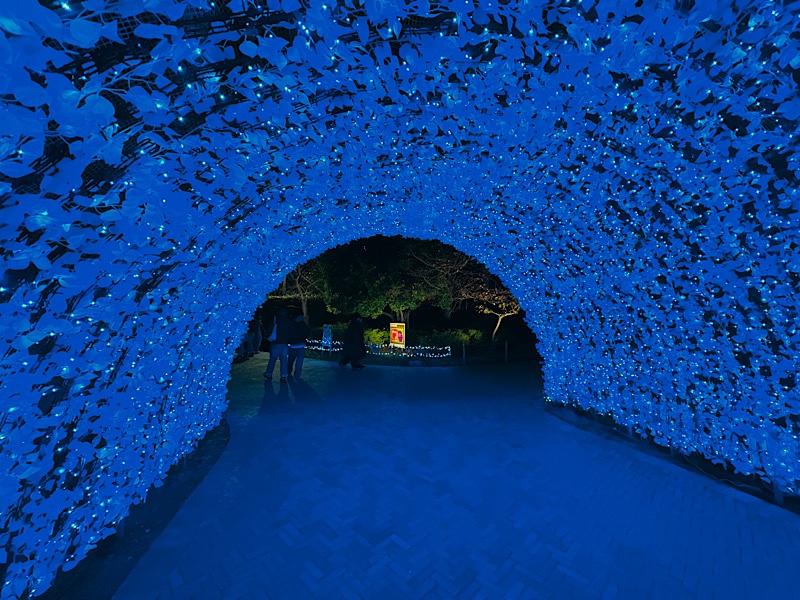


 Highspeed landscape photography isn’t really a thing, but you can get a bit of an idea of what the countryside looks like.
Highspeed landscape photography isn’t really a thing, but you can get a bit of an idea of what the countryside looks like.


 After a 40 minute bus ride, we reached our destination, the entrance to the park. Unsurprisingly, the few restaurants and inns out here seem to use monkeys in their logos.
After a 40 minute bus ride, we reached our destination, the entrance to the park. Unsurprisingly, the few restaurants and inns out here seem to use monkeys in their logos. The park entrance leads the way to the 1.6km walk to the thermal pool that the Japanese macaques congregate in during the winter, and it is the only way to access the area. Jigokudani means, ‘Hell’s Valley’ due to the steam and boiling water that is found in the geothermal valley. It is surrounded by steep cliffs that in winter make for a formidable and hostile landscape.
The park entrance leads the way to the 1.6km walk to the thermal pool that the Japanese macaques congregate in during the winter, and it is the only way to access the area. Jigokudani means, ‘Hell’s Valley’ due to the steam and boiling water that is found in the geothermal valley. It is surrounded by steep cliffs that in winter make for a formidable and hostile landscape.
 The walk into to the monkey’s thermal pools is fairly flat with only two steep-ish areas, though in these conditions it is very slippery with ice. We all had decent hiking books on but more than one of our party went arse over (including me) on the ice. Ice or no, it sure is beautiful to see the valley covered in a layer of fresh snow.
The walk into to the monkey’s thermal pools is fairly flat with only two steep-ish areas, though in these conditions it is very slippery with ice. We all had decent hiking books on but more than one of our party went arse over (including me) on the ice. Ice or no, it sure is beautiful to see the valley covered in a layer of fresh snow.














 The drive back from the park afforded some beautiful views of the mountains in the Nagano area. The Winter Olympics were held here nearly 20 years ago, but the locals like to keep showing that one off with souvenirs still available and signs to the event sites.
The drive back from the park afforded some beautiful views of the mountains in the Nagano area. The Winter Olympics were held here nearly 20 years ago, but the locals like to keep showing that one off with souvenirs still available and signs to the event sites. After visting the snow monkeys we made out way to the Zenkō-ji temple, one of the most famouse Buddhist temples in all of Japan. The original temple was built in the 7thC AD and the city of Nagano which was established in 1897 was effectively built up around the temple area. HIstorically Zenkō-ji is famous for it’s use as a staging point in the battles between Uesugi Kenshin and Takeda Shngen in the 16thC. It is also one of the few temples which serve as a pilgrimage site in Japan.
After visting the snow monkeys we made out way to the Zenkō-ji temple, one of the most famouse Buddhist temples in all of Japan. The original temple was built in the 7thC AD and the city of Nagano which was established in 1897 was effectively built up around the temple area. HIstorically Zenkō-ji is famous for it’s use as a staging point in the battles between Uesugi Kenshin and Takeda Shngen in the 16thC. It is also one of the few temples which serve as a pilgrimage site in Japan.

 This hibutsu hidden Buddha, is rumored to be the very first Buddha statue ever brought to Japan and it is by ‘commandment’ of the temple that the absolute secrecy of the statue is maintained. Even the chief priest of the temple is unable to view it. The first replica however, (not the one above) is shown publicly once every six years in the spring time in a truly bizarre special ceremony called Gokaichō.
This hibutsu hidden Buddha, is rumored to be the very first Buddha statue ever brought to Japan and it is by ‘commandment’ of the temple that the absolute secrecy of the statue is maintained. Even the chief priest of the temple is unable to view it. The first replica however, (not the one above) is shown publicly once every six years in the spring time in a truly bizarre special ceremony called Gokaichō. 
 Nearby is the Scholar’s Shrine – students will come here to make offerings to pass their exams. They will give their coins, write on a stone their desire to pass their tests, and then strike the gong using the rope. Passing exams in Japan can mean the difference between a happy life of lifelong prosperity working for a good company, and a life of destitution floating from job to job. Obviously, the pursuit of a ‘life-job’ is become less of a goal in the fluid modern job market.
Nearby is the Scholar’s Shrine – students will come here to make offerings to pass their exams. They will give their coins, write on a stone their desire to pass their tests, and then strike the gong using the rope. Passing exams in Japan can mean the difference between a happy life of lifelong prosperity working for a good company, and a life of destitution floating from job to job. Obviously, the pursuit of a ‘life-job’ is become less of a goal in the fluid modern job market.



 A very sad monument to children and babies that have died. People who visit this shrine all have a very heart-wrenching story to share. There are two shrines dedicated to this purpose in the temple complex.
A very sad monument to children and babies that have died. People who visit this shrine all have a very heart-wrenching story to share. There are two shrines dedicated to this purpose in the temple complex.
 Pilgrims sandals hung on the outside of the Niōmon gate hung when pilgrims set off on their journeys to give them good strong legs for their endeavours. Also hung here can be found pairs of ballet slippers for aspiring ballerinas who also want to have good strong legs for their careers.
Pilgrims sandals hung on the outside of the Niōmon gate hung when pilgrims set off on their journeys to give them good strong legs for their endeavours. Also hung here can be found pairs of ballet slippers for aspiring ballerinas who also want to have good strong legs for their careers. The interior of the Sanmon gate is covered in plastered on papers or stickers bearing people’s names. While it is illegal to place these stickers, it is said that the higher you place your name, the higher you are towards enlightenment. Some very determined individuals have their names as much as 6m off the ground. Oddly (given you are literally leaving evidence of your crime) no one is ever prosecuted for leaving a name sticker due to Japanese naming protocols leaving so many people with identical or similar names.
The interior of the Sanmon gate is covered in plastered on papers or stickers bearing people’s names. While it is illegal to place these stickers, it is said that the higher you place your name, the higher you are towards enlightenment. Some very determined individuals have their names as much as 6m off the ground. Oddly (given you are literally leaving evidence of your crime) no one is ever prosecuted for leaving a name sticker due to Japanese naming protocols leaving so many people with identical or similar names. Another shrine, this time dedicated to long life and good health. This shrine is the ‘reason’ that the people of Nagano are known to live the longest lives, of all the Japanese people. Nothing to do with healthy living and good diets, it is this little shrine which brings them longevity.
Another shrine, this time dedicated to long life and good health. This shrine is the ‘reason’ that the people of Nagano are known to live the longest lives, of all the Japanese people. Nothing to do with healthy living and good diets, it is this little shrine which brings them longevity. This bronze oxen has a special house to himself and he has come to represent ‘Unexpected Good Fortune’. The story of the oxen includes a washerwoman who did not believe in spending her time going to the shrine to pay her respects to Buddha. While the rest of the townsfolks would go to the shrine, she instead would go to the river to wash her clothes. Buddha was annoyed by this, and one day he turned himself into an ox and ran through the washerwoman’s clothes collecting them on his horns. Away he ran, with the washerwoman following him, to the shrine, whereupon he turned into his proper self and showed himself to the washerwoman wearing the clothing she had been washing.
This bronze oxen has a special house to himself and he has come to represent ‘Unexpected Good Fortune’. The story of the oxen includes a washerwoman who did not believe in spending her time going to the shrine to pay her respects to Buddha. While the rest of the townsfolks would go to the shrine, she instead would go to the river to wash her clothes. Buddha was annoyed by this, and one day he turned himself into an ox and ran through the washerwoman’s clothes collecting them on his horns. Away he ran, with the washerwoman following him, to the shrine, whereupon he turned into his proper self and showed himself to the washerwoman wearing the clothing she had been washing.
 Outside the temple are statues of six Bodhisattvas (followers of Buddha), who gave up their own pursuit of Buddhist enlightenment, in order to help and provide salvation to others. The Bodhisattvas are said to represent and be able to commune with the six realms of hell, starvation, beasts, carnage, human beings and divine beings. The Bodhisattva on the right with his foot dangling in the mortal world is the one representing hell.
Outside the temple are statues of six Bodhisattvas (followers of Buddha), who gave up their own pursuit of Buddhist enlightenment, in order to help and provide salvation to others. The Bodhisattvas are said to represent and be able to commune with the six realms of hell, starvation, beasts, carnage, human beings and divine beings. The Bodhisattva on the right with his foot dangling in the mortal world is the one representing hell.
 This is the main temple of the Zenkoji temple complex. Inside is housed five sacred wooden statues, which, you guessed it – are not available for public viewing. Also inside the temple is a statue of Binzuru, a physician who was said to be Buddha’s follower. Visitors to the temple touch the statue in order to cure their ailments – so if you have bad knees you touch his knees, if you have a bad back… you get the idea. The statue of Binzuru is made of wood and is 300 years old, I’m surprised that people are still allowed to touch a religious artefact of this age – but of course I rubbed his back anyway!
This is the main temple of the Zenkoji temple complex. Inside is housed five sacred wooden statues, which, you guessed it – are not available for public viewing. Also inside the temple is a statue of Binzuru, a physician who was said to be Buddha’s follower. Visitors to the temple touch the statue in order to cure their ailments – so if you have bad knees you touch his knees, if you have a bad back… you get the idea. The statue of Binzuru is made of wood and is 300 years old, I’m surprised that people are still allowed to touch a religious artefact of this age – but of course I rubbed his back anyway! 


 This prayer wheel had many characters engraved into it but over the centuries has been largely worn smooth. Observants would touch the prayer wheel to feel the characters of their prayers and spin the wheel to pray before the temple.
This prayer wheel had many characters engraved into it but over the centuries has been largely worn smooth. Observants would touch the prayer wheel to feel the characters of their prayers and spin the wheel to pray before the temple.  Within the temple district is this one Shinto shrine – the Japanese tend to be born as Shinto, marry as Shinto and/or as Christians (they like the big white fluffy princess wedding dresses!) but they die and have their funerals at Buddhist temples surrounded by the ideas of rebirth into the next life.
Within the temple district is this one Shinto shrine – the Japanese tend to be born as Shinto, marry as Shinto and/or as Christians (they like the big white fluffy princess wedding dresses!) but they die and have their funerals at Buddhist temples surrounded by the ideas of rebirth into the next life. At this shrine was rows and rows of little men standing only about four inches tall, that all have the names of important ancestors in history on them. People come and search the racks for their own names, and leave small offerings (in the form of beaded necklaces for the little statues) to honour their family ancestors.
At this shrine was rows and rows of little men standing only about four inches tall, that all have the names of important ancestors in history on them. People come and search the racks for their own names, and leave small offerings (in the form of beaded necklaces for the little statues) to honour their family ancestors.
 The other shrine dedicated to children who have passed away – this one is much more widely used and is more popular for some reason. It is surrounded by offerings made by mourning parents who wish to send their children into the afterlife with tokens, such as toys or clothing items.
The other shrine dedicated to children who have passed away – this one is much more widely used and is more popular for some reason. It is surrounded by offerings made by mourning parents who wish to send their children into the afterlife with tokens, such as toys or clothing items.  After we visited the temple, we made our way to a nearby sake brewery. Where we were treated to a sake tasting of 6 different varieties of sake, three varieties of amazuke and some really unusual sparkling yuzu sake. A very welcome warming of the cockles after a day in the cold. 🙂
After we visited the temple, we made our way to a nearby sake brewery. Where we were treated to a sake tasting of 6 different varieties of sake, three varieties of amazuke and some really unusual sparkling yuzu sake. A very welcome warming of the cockles after a day in the cold. 🙂 



 After that it was back to Nagano Station to hightail it back to Tokyo Station on the amazing (I want one!) bullet trains. I seriously love these trains, so fast, so clean, lots of leg room, power points, a lovely lady with a tea trolley and before you know it – you are at your destination.
After that it was back to Nagano Station to hightail it back to Tokyo Station on the amazing (I want one!) bullet trains. I seriously love these trains, so fast, so clean, lots of leg room, power points, a lovely lady with a tea trolley and before you know it – you are at your destination.
 We then made our way back to Shinjuku for a bit of late night shopping (Shell, if you are reading this, I have stocked up on sunscreen!), and a bite to eat at a cheerful little ramen restaurant.
We then made our way back to Shinjuku for a bit of late night shopping (Shell, if you are reading this, I have stocked up on sunscreen!), and a bite to eat at a cheerful little ramen restaurant.  Found what appeared to be the Attagirl outlet store – no knee pads though… #confused
Found what appeared to be the Attagirl outlet store – no knee pads though… #confused
 Shinjuku is really quite lively any time of the day – but at night time it really seems to come alive and is transformed into the Tokyo we have all become familiar with from movies and tv. People are everywhere, the lights of the advertising don’t just rival Times Square in New York, but completely eclipse it. The atmosphere here at the momen is just electric – everyone is cheerful and doing their Christmas shopping and carols are steaming out of all the stores. It’s been a huge day, so after our shopping/dinner in Shinjuku it was back to the hotel for another well deserved soak in the tub!
Shinjuku is really quite lively any time of the day – but at night time it really seems to come alive and is transformed into the Tokyo we have all become familiar with from movies and tv. People are everywhere, the lights of the advertising don’t just rival Times Square in New York, but completely eclipse it. The atmosphere here at the momen is just electric – everyone is cheerful and doing their Christmas shopping and carols are steaming out of all the stores. It’s been a huge day, so after our shopping/dinner in Shinjuku it was back to the hotel for another well deserved soak in the tub!
 The
The